revue
• Arden: lifting the bar in urban renewal
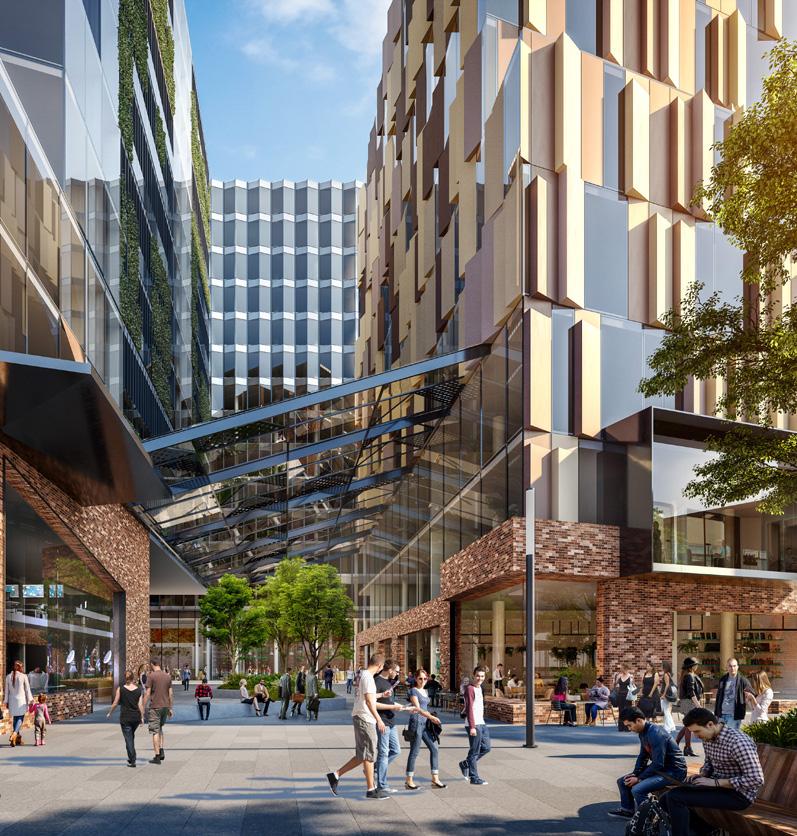
• Priority Project Panels
• Local Government… efficient?.. effective?
• Clarkfield; big dreams for a small town
• Net zero emissions: sustainable, or political?
• New VPELA board members
• Collingwood; planning for an evolving industry
victorian / planning / environmental / law / association / volume 113 October 21







2 / VPELA Revue October 2021 Contents Places Arden: Innovative planning controls lift the bar for urban renewal in Melbourne 9 Clarkefield: Dreaming big for a small new township 20 Collingwood: Planning for an evolving industry 29 Webinar: Net zero emissions: A grand vision for a sustainable future or a vacuous political position? 35 Webinar: Electrify everything 39 President 3 Editorial Licence 5 The Minister for Planning 8 Shadow Minister for Planning 13 People Meet our new board members 4 Paul Jerome Award – Phillip Priest 7 From ‘A Resilient Career’ program: Reflections 16 Connecting from a distance 27 Young Professional Group 2021 event wrap up 33 The Business Priority Projects Standing Advisory Committee 11 Local and State Government, efficient, effective… and fit for the 21st century? 14 Suburban Rail Loop: an extraordinary new planning authority 18 Legal World 22 Fast Lane 24 ‘Switching off’ the garden area requirement 25 Everything you wanted to know about adverse possession 31 Victorian Government School Site Selection Criteria Guidelines and Toolbox 38 Cover: Arden graphic courtesy Victorian Planning Authority Newsletter editor: Bernard McNamara
0418 326 447
bernard.mcnamara@bmda.com.au T: 9699 7025 VPELA PO Box 1291 Camberwell 3124 www.vpela.org.au E: admin@vpela.org.au T: 9813 2801
M:
E:
The President
Tamara Brezzi President, VPELA
Hopefully this article finds each of you well and enjoying, or about to enjoy, the benefits of a springtime ‘Unlock’. It seems that the planning, environment and development sectors remain extremely busy as the year draws to a close. VPELA has also had a busy year and continues to adapt in order to deliver its program of seminars and events online and I wanted to take this opportunity to thank the Board and VPELA membership for their hard work and continued participation throughout 2021.
One of the projects that VPELA has been working on throughout 2021 concerns the Development and Infrastructure Contributions Plan system and the review of the system being carried out by an Advisory Committee lead by Jude Munro AM. In the context of that review, a colleague drew my attention to a program being run in the City of Greater Shepparton which is designed to procure public infrastructure in partnership with the private sector so that infrastructure can be delivered by Council at an earlier stage of development than might otherwise have been possible.
I commend the Council for its pro-active and innovative approach in dealing with this issue. While the planning system for the preparation of DCPs has matured over the years and has evolved in its level of sophistication, the systems concerning the physical delivery of infrastructure have commonly been left to languish in a mess of Works in Kind agreements, difficulties with land acquisition for the construction of infrastructure, funding of works, obtaining agreement between authorities and developers concerning the scope of works, credits to be obtained for those works and being able to ensure that the works are delivered to a standard that will serve communities well into the future.
The adopted policy allows developers to seek Council funding to deliver Works In Kind infrastructure. The Council takes the view that it is going to be required to deliver the land and infrastructure at some point in the future anyway (where that is included within an approved DCP), so it views a WIK proposal that involves Council finance as beneficial.
While the procurement policy at the City of Greater Shepparton does not solve all of these issues, it does go some way down the path of recognising that infrastructure delivery can occur in a variety of ways and facilitates a solution to the forward funding issues that have often been source of insurmountable problems with delivery of infrastructure in the past.
The policy applies:
• in circumstances where Public Infrastructure Works are required by Council as a result of, or in association with, a new use and/or development approved by way of a planning permit or otherwise under the Planning Scheme.
• to public infrastructure and any associated contributions that may arise by way of an approved development contribution plan, an
approved development plan, an incorporated plan, a section 173 agreement or the like.
• to the purchase or acquisition of Public Infrastructure Works Land, including where that land may be used as an offset for a Development Contribution.
• to Subdivision Permit Works where those works are done in conjunction with Public Infrastructure Works and/or in conjunction with the acquisition or purchase of Public Infrastructure Works Land.
Details of the policy can be found on the Council’s website and in the Council agenda paper of 20 July 2021.
I draw to your attention that we are planning an in person Christmas Party again this year, on 7 December, and very much hope to see you there or at any of our many webinars scheduled for the remainder of 2021. All my very best wishes for the remainder of the year and for a restful holiday period.
STOP PRESS 2021 BOARD ELECTION RESULTS
VPELA would like to congratulate sitting Board members Jodi Kennedy and Colleen Peterson who were successfully returned in our recent election.
Warm congratulations to Sarah Carlisle, Planning Panels Victoria and Marjorie Kennedy, City of Melbourne who were also elected. A full profile of our new members is included on page 4.
VPELA would like to take this opportunity to thank departing Board members Frank Butera and Jane Sharp for their outstanding commitment to and support of the Association. Both have been Executive and Board members for many years and their contribution is incalculable. They have been involved across all of our activities; each has served as Treasurer for the Association and Jane Sharp has also been Vice-President Legal for the last few years. They have both organised and participated in seminars and conferences, represented the Association in many policy and legislative reviews, prepared submissions and provided exceptional support to the Board in decision making. We wish them both well for the future and know they will continue to be active members of the Association.

VPELA Revue October 2021 / 3
Tamara Brezzi is President of VPELA and a Partner at Norton Rose Fulbright
People Meet our new board members
Sarah Carlisle, Planning Panels Victoria
Sarah is a planning and environmental lawyer with over 20 years’ experience in private practice in Victoria and the UK, and in State Government.
After five years working as a specialist planning lawyer within DELWP, Sarah joined Planning Panels Victoria in 2015 – first as a sessional member, and then as a Senior Panel Member. She loves her job, and values the opportunities it presents to facilitate inclusive and meaningful participation in planning decisions, and make a valuable contribution to planning policy, planning scheme amendments and development approvals.

PPV is at the forefront of major planning and environmental issues and policy developments. Through her time at PPV, Sarah has developed particular expertise and interest in growth area planning, infrastructure contributions, affordable and social housing, structure planning for activity centres and urban renewal areas, and environmental assessment processes. She hopes to make a significant contribution to VPELA’s continued leadership in these areas.
Sarah has been on a number of significant Panels and Advisory Committees. One of her first was the Macedon Ranges Protection Advisory Committee, which recommended a process for the protection of the Macedon Ranges on which the Distinctive Areas and Landscapes legislation was later based. She was a member of the Fishermans Bend Planning Review Panel, Deputy Chair of the Social Housing Renewal Standing Advisory Committee, a member of the Managing Residential Development Standing Advisory Committee, and Chair of both the Golden Plains Wind Farm and Golden Beach Gas Project EES Inquiries. Sarah is now the Lead Chair for the VPA Standing Advisory Committee.
Sarah believes that one of VPELA’s great strengths is its multidisciplinary membership, and its facilitation of knowledge sharing and collaboration between different parts of the profession. Like VPELA, Sarah considers that knowledge sharing and collaboration promote excellence, and are critical as we collectively strive to create better, more inclusive cities and towns and a healthier, more resilient environment.
Sarah has been a VPELA member for most of her career. VPELA’s conferences, seminars and networking events have been an integral part of her career development. Sarah is looking forward to giving back to the organisation that has supported her over her career through serving on the Board.

Sarah has benefitted greatly from the guidance and mentorship of former VPELA President and current Chief Panel Member Kathy Mitchell AM. She has learnt an enormous amount from Kathy,
and hopes to be able to make a similar contribution through VPELA’s ongoing mentoring and professional development programs.
On a personal note, Sarah grew up in Torquay and Elwood, and comes from a long line of South Melbourne supporters. She loves cooking, travelling (if we ever get back to that), skiing, bushwalking and gardening. She’s tried and failed to learn French, Italian and Spanish. If she had to choose a different career, it would have been architecture.
Marjorie Kennedy, City of Melbourne
Marjorie grew up in a completely offthe-grid property, in a house built by her Step Dad and his brothers in Harcourt in central Victoria before moving to the city to start her first degree in Environmental Studies. After attending a lecture in Statutory Planning (thanks Alan March) she and a few others decided to jump the fence and complete a double degree.
Marjorie started her career as a Student Planner at the City of Boroondara where she learnt the ropes, made some of lifelong friends and had exposure to a very well educated and resourced community whose expectations were incredibly high. Marjorie then wanted to see how the other side of the coin operated and worked at SJB Planning, where she had a whole new experience of commercial realities, the art of negotiation and timesheets. Attending evening legal conferences and listening to the strategy and thought processes of legal counsel were the most memorable and eye opening part of her time in the private sector.
Marjorie recently started a new role as Statutory Planning Manager at the City of Melbourne as part of a new and exciting department structure. Despite changing jobs in the middle of a pandemic, the new role has given her energy and motivation, through incredible exposure to a wide range of economic, social and built form issues facing the city and an impressive calibre of people to work alongside.
When not planning towns, Marjorie is likely to be found taking photos of her food (most likely a croquette), drinking gin on the banks of the Supernatural Amphitheatre or spoiling to her rescue cat Poppy.
Having worked both in private and local government Marjorie understands and empathises with the challenges of both sides and hopes she is known as someone who is approachable, proactive, honest (perhaps at times a little too honest), sees the big picture and enjoys a lively debate.
Marjorie really looks forward to catching up at a VPELA event, hopefully paired with a drink on a rooftop soon.
4 / VPELA Revue October 2021
Editorial licence
Bernard McNamara Editor and Director, BMDA Development Advisory

And so we come to late 2021, which seems like we are stuck in 2020. The loneliness of the office has inverted to the hitherto remoteness of the staying at home.
Normally this issue of the Revue is a bit of a ‘soda’ for the Editor, being bulked up by the large offerings provided by the Conference papers and events. Cancelled again, we have instead provided opportunities for members to write on matters and from various perspectives. Thanks, VPELA members, you have delivered again!
Our changing infrastructure challenges
Many commentators are forecasting the demise of our cities, caused by the pandemic being countered with the technology advances in the on-line environment. An authoritative view may be found in Infrastructure Australia’s recent report, wherein changes in infrastructure needs are identified. In 2019/20, IA’s major priorities were focused on the big transport projects. In 2021, IA is identifying a higher need on ‘place-based outcomes’; for communities within all the ‘fast-growing cities’ of Sydney, Melbourne, Brisbane and Perth, plus in the fast growing smaller cities and regional centres.
The Australian Government Centre for Population has projected that 1 in 10 Australian workers will likely increase their pattern of working from home to 2-3 days per week. This will increase the attraction of living in the smaller cities and regions, with reductions in journey to work hours and costs. Bernard Salt sees a range of impact extending to a radius outside the capital cities of about 150km. It might extend further.
The shift has led IA to recommend changes in our infrastructure spend which, in Victoria, is heavily focused on Melbourne (think City rail loop, LXRPs, SRLP, Monash Freeway, N-E Link and others). The regional infrastructure projects, while not insignificant, pale into the background against the costs of these.
Dare one ask the question as to whether the best bang for our (borrowed) bucks is to continue with all of these mega projects, or to change course, a bit? (Think submarines.)
It is not well publicised, but Victoria’s net state debt at $87billion is higher that the state debts of NSW and Queensland combined. This level has doubled and will be nearly double again in 2024. It’s just not discussed. (?)
Perhaps it is time for Infrastructure Victoria to question the current directions. The $1.10 benefit for every $1 invested on one part of the suburban rail loop project looks a bit thin when we can see the record of LXRP cost blowouts.
Local Government: ‘Wrong way, go back’?
We are indebted to VPELA ‘champion’ Jane Nathan for her article. As a former Councillor, Mayor, Commissioner and Administrator, Jane has tackled local government management from every angle. Jane is a former president of VPELA and the recipient of the Richard J Evans Award. Her view as to the current state of local government administration is unsettling. The supposed ‘amalgamation efficiencies’, the abrogation of local responsibilities by the State, accompanied by the increased politicisation of Councillor elections are identified as the problems. The casualties Jane sees, are the promised for cost efficiency, improved liveability and local participation.
Jane sees instead, the increased politicisation, and increased professional management within many LGA, leading to detached and formulaic outcomes. The ‘local’ is not what was promised.
An interesting observation (and which I agree with) is that local communities do very well when a Council is under administration. These appointed, (and generally highly qualified people) carry no ‘baggage’, and do not need to respond to political requirements. Their positions are not as steppingstones into higher levels of government. The sometimes “grandstanding’ at Council meetings is replaced with calmer and more focussed management.
Having represented investors/developers before Councils and administrators, I believe the community is provided with better outcomes from the latter. Simply, a party knows where it stands with administrators when, if it agrees to changes/contributions, these will be honoured. The risks with the alternative might see hard won negotiated outcomes with Council executives being overturned at Council level.
Is the next step in local government reform to be a combination of administrators receiving advice from an elected community panel?
Permits and development approvals… morphing to a new model?
The biggest game in town (after of course, the City Loop, LXRA, West Gate Tunnel. SRLA works) is the roll out of the social and community housing investment. Ben Rimmer, CEO of Homes Victoria wrote about the $5.5billion program in the June Revue.
A determined Government has re-written the planning rule book by exempting virtually all State Government, State Government agencies and local government projects from requiring a Planning Permits, which will include all the social and community housing projects. There are grounds for these actions given the state level significance of some of these programs.
…continues over page
VPELA Revue October 2021 / 5
David Davis in his last contribution to the Revue as the Shadow Minister for Planning identifies further legislative amendments and practices through with the State will extend its confidential and directive approach. (May I thank David for always fulfilling his commitment to providing a contribution to the Revue and welcome the new Shadow Minister for Planning, Ryan Smith).
What I reflect on is the program of Planning Reform that Minister Wynne launched in 2019 wherein the ambitious agenda contained a ‘no-go’ area, being the removal of third party rights of notification, objection and appeal rights.
But now, for large sections of the community, the removal of the rights to have any say in any of these mega or major and sometimes small scale projects would be more impactful than having such rights in the case of the ‘two unit development next door’.
The question now is, given that these (major and multiple) alternative processes are running, why not go further? Should the review of third party rights go on the agenda? My observations from working in NSW is that the urban environment does not appear to have been trashed because of the absence of third party rights for most development applications. If we, as a community are about efficiency and fairness, but with care, can this be achieved via other means than the preservation of third party rights for some items? The long list of considerations set out in say, Cl 52.30 would appear to suggest that the State considers that they can be. Can the private sector be offered similar efficiency with fairness arrangements? (It could be……. but I know the answer.)
A Resilient Career… a brilliant initiative!
In a classical auto-correct typo, Meg Lee sent the article (that she, with Maria Marshall had prepared) with the erroneous title ‘A Brilliant Career’. This is the new VPELA supported program aimed to assist VPELA members in mid-career adjustments, brought about for various reasons. Common reasons relate to professionals who have taken a break for family reasons, but the program is open to others.
The program is a brilliant initiative indeed. It goes to the heart of VPELA and why it has prospered. VPELA has for many years
operated a mentoring program for new graduates, via the VPELA ‘buddy’ program, whereby a Board member is partnered with a YPG member for career advice and for increased connectiveness.
The Resilient Career program will address a different need. Career progression is not always linear and is not assisted by a mid-career break. While not wishing to over-connect these events, Meg and Maria draw our attention to recent tragic events where VPELA members, Phil Bissett, Phil Hanna and Annabelle Viner ended their own lives. Could better connections have changed these actions? Congrats go the VPELA Board for commencing this program.
New Board members
It is always of great interest when new members take the step up to join the VPELA Board. My congratulations go to new members Sarah Carlisle, Planning Panels Victoria, Marji Kennedy, City of Melbourne and returned members Jodi Kennedy, Bass Coast Shire and Colleen Peterson, Ratio. The annual Board elections have become very competitive. The numerous, and well credentialled candidates who were unsuccessful deserve our thanks for their willingness to seek the responsibility.
May I also commend retiring Board member, Jane Sharp, who has elected not to re-stand. Jane joined the Board in 2006, and moved into the Executive team in 2010, and then became Treasurer when I left the Board in 2014. Thanks, Jane, for your efforts in guiding VPELA to safe and responsible positions. Thanks too are due to our current Treasurer Frank Butera who is also retiring this year. Frank joined the Board in 2012 and took over as Treasurer in 2018. He has successfully overseen our financial operation during the Covid pandemic and his legacy is significant. We look forward to Jane and Frank’s continued involvement in the Association for man years to come.
And, check out the ‘bard of Spring Street’, Kathy Mitchell AM, with her article on the Priority Projects Standing Advisory Committee and working through Covid.
In closing… wishing you an open, ‘fully vaxed’, Australia with plenty of friendships and greetings over summer.
As always, comments, articles, etc, to Bernard.mcnamara@bmda.com.au
6 / VPELA Revue October 2021
People Paul Jerome Award
VPELA instituted The Paul Jerome Award in 2005 in memory of our esteemed colleague and VPELA Board Member, Paul Jerome. The award is part of VPELA’s commitment to encouraging, recognising and supporting work in public administration. The purpose of the award is to recognise outstanding contribution to public service in the image of Paul Jerome. Unfortunately, with the cancellation of the VPELA conference at which this award is usually made, the presentation has been deferred until our next large in-person event. In the meantime, we congratulate Phil on this honour which is so well deserved.
community pressures to limit development and pursuing urban consolidation in Moreland’s activity centers and transit corridors. As the manufacturing industry dwindled in the 80’s and 90’s, Phil oversaw a seismic shift in Moreland’s industrial precincts that has seen them embrace change and become exemplars for inner city urban renewal.
During his time, Moreland has earned a reputation as a pioneer and leader in Local Government planning circles. He has led many planning initiatives including the Moreland Apartment Design Code prior to the introduction of BADS, the introduction of the ESD Policy in the Moreland Planning Scheme and more recently initiatives to reduce emissions. He has championed planning leadership at Moreland through proactive, forward looking initiatives such as VicSmart for 2 lot subdivisions.
These are consistent with Phil’s unwavering commitment to process improvement and driving efficiencies.
Congratulations to our 2021 recipient Phillip Priest
When planners think of Moreland Council, they think of Phil Priest. Phil has been a mainstay in planning in the inner city for decades, providing exemplarily service to the public sector and leading Moreland’s successful transition from a dying industrial heartland to a beacon for inner city urban renewal. Phil earnt his stripes at City of Melbourne, before joining Moreland in 2003 as the Manager of Urban Development. For the next 17 years, he had a variety of managerial and planning roles, including Group Manager City Development, where he led multidisciplinary teams of over 70 professionals with responsibilities for town planning, building and environmental health.
After a brief stint at DELWP as the Director of Developer Approvals and Design, Phil has returned to his old stomping ground at Moreland Council as Acting Director City Futures.
But Phil’s contribution to planning and the public sector goes beyond titles. He is very approachable, facilitative and reasonable, always finding a sensible balance between local

Phil directed the implementation of a digital planning system at Moreland, well before others. This proved fortuitous when Covid hit, with Moreland well prepared for the mad scramble away from paper. A quick look at the Moreland website today shows a leading Council who understands their community’s needs and the responsibilities of an effective planning system.
Phil is particularly supportive to planners entering the industry and provides an excellent working environment where staff are encouraged to succeed. His sensible approach and ‘can do’ attitude has earnt him a solid reputation amongst planners and the wider industry.
Phil has lent his considerable skills to public sector planning, and has achieved much for his community not just at Melbourne and Moreland but further afield, and accordingly is a worthy recipient of the Paul Jerome Award.
Citation prepared by Adam Terrill, VPELA Board Member & Director of Planning, Equis
Proudly sponsored by Contour

VPELA Revue October 2021 / 7
Melbourne’s Future Planning Framework
Great cities like Melbourne aren’t born, they’re made. We’re making sure our city remains a great place to live, work and visit - by calling for your feedback on our plan for what Melbourne will look like in the future.
Melbourne’s Future Planning Framework (MFPF) is a 30-year strategic land-use and infrastructure plan that will guide future planning and growth across metropolitan Melbourne.
As our city grows, we need to make sure that Victorians have access to housing, roads and rail, public transport options, schools, shops, agricultural land, industrial and advanced manufacturing areas, and anything else they need to live a productive and happy life.
Melbourne is rich and diverse.
To accommodate that the MFPF has been broken down into six tailored Land Use Framework Plans, covering Melbourne’s six metropolitan regions to make sure we deliver exactly what each region needs.
The Land Use Framework Plans build on existing work at the state, regional and local level and will identify gaps in strategic planning, focusing on the key areas of productivity (jobs and investments), housing choice, integrated transport, liveability, strong communities and sustainability and resilience.
Among the aims of the Land Use Framework Plans will be identifying areas in metropolitan Melbourne where land will be set aside primarily for business and employment-generating purposes. This will be based on extensive engagement with a wide group of stakeholders, ranging from planners and councils to industry.
They also identify locations where a mix of higher-density residential, commercial, and other activities are encouraged, and sites where urban renewal precincts and medium and
higher-density housing and mixed-use development will be encouraged.
To make sure these growth areas are well serviced, they will provide an access framework to make sure that activity centres, employment and tourism precincts are supported by walking, cycling, public transport and in some cases, night-time travel options.
They’ll also help identify any transport opportunities that may arise from major transport infrastructure projects.
Meanwhile, they will help lay the foundation for providing communities with better access to community, health, education, recreation, sporting, and cultural facilities, while providing additional open space networks and enhancements and greening initiatives.
There will also be a 2050 spatial plan, this will provide an overview of the key planning concepts. The spatial plans will show the major strategies already established by Plan Melbourne and existing and proposed strategies that contribute to long-term planning for Melbourne.
There’ll be a five-year action program for State and local governments to give effect to the strategic directions of the landuse framework plan and in turn, Plan Melbourne.

These actions are in addition to Plan Melbourne actions and the range of initiatives which support the achievement of Plan Melbourne outcomes already underway across state and local government.
Ultimately, we’re laying the foundations for what Melbourne will look like in the next 30 years. I encourage everyone to give feedback on our plans for Melbourne, to make sure it continues to be a great place to live, work and visit.
8 / VPELA Revue October 2021
Minister
The Hon. Richard Wynne MP Victorian Minister for Planning
Places Arden: Innovative planning controls lift the bar for urban renewal in Melbourne
The Victorian Planning Authority has released the draft plans for the Arden precinct, bringing the ambitious vision for the precinct to life through innovative planning controls that will set the standard for urban renewal in Victoria.
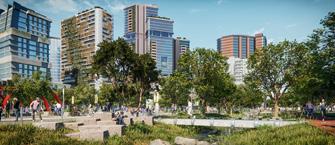
The VPA is leading structure planning and planning controls for Arden, with Government policy, delivery and coordination for the precinct being directed by the Department of Transport, all in close collaboration with the City of Melbourne.
Building on the Victorian Government’s investment in cityshaping infrastructure, the Arden precinct is a platform for sustainability, liveability, investment, and innovation.
Stuart Moseley, CEO, Victorian Planning Authority

Arden is a 44-hectare urban renewal area located around the new Arden Station in North Melbourne. With the completion of the Metro Tunnel and the new Arden Station by 2025, Arden will become a new destination for Melbourne and an employment hub on the doorstep of the central city.
The Metro Tunnel will create a new chapter for Arden by linking the precinct to the Parkville National Employment and Innovation Precinct and the city to the east, Footscray and Sunshine to the west, and Melbourne Airport Rail when it opens in 2029.
Arden will be an employment and innovation precinct and a thriving new neighbourhood for Melbourne’s inner north-west. It aspires to accommodate approximately 34,000 jobs and be home to around 15,000 residents.
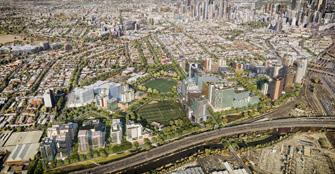
The heart of the precinct will develop into an employment and innovation hub with life sciences, health, digital technology, and education sectors at its centre, advancing Melbourne’s strengths as a progressive, innovative, and connected global city.
Residents, workers, and visitors will be able to enjoy vibrant streets and open spaces, new schools and community facilities, innovative water management and well-designed buildings to live and work in, including affordable housing options. The wellconnected streets will encourage people to get around by foot or bike.
This aspirational vision for Arden is brought to life through planning controls for open space, transport and parking, integrated water management and sustainability that sit at the forefront of urban renewal practice in Australia.
Open space
The draft planning scheme amendment proposes more than 9.09ha of new green open space and new community spaces. In total, open space will account for around 28 per cent of land within the precinct, with strong built form controls in place to protect those spaces from overshadowing and wind.
Transport and parking
Guided by Plan Melbourne’s 20-minute neighbourhood principle, transport planning for the precinct is focussed on delivering great streets and public spaces to make walking and cycling the most convenient ways to move around the precinct and access daily needs.
Parking in Arden will be controlled by innovative new planning controls like preferred maximum car parking rates aimed to discourage individual onsite parking, and encourage consolidated, publicly available car parking.
Carpark facilities will be encouraged to provide a diverse range of parking options, including car share spaces and spaces equipped for electric vehicle charging.
Arden’s innovative consolidated carparking approach encourages more efficient use of parking spaces as they can serve different uses at different times, e.g., the same parking space can serve a worker during the day and a resident at night. This has reduced the number of parking spaces and structures needed to service the precinct, which in turn makes Arden a more inviting and people-friendly neighbourhood.
Integrated water management
The precinct is low-lying and prone to flooding, but the plans’ leading approach to integrated water management will not only make the precinct developable, but it will also define its character and identity.
VPELA Revue October 2021 / 9
Water will be central to Arden’s identity and will be a positive, visible feature of the precinct. Visible stormwater management measures will slow and store stormwater and support ecology and biodiversity while celebrating water in the landscape.
A central feature of the precinct will be a new integrated stormwater management open space which will be designed to flood during major rain events while also providing for active recreation and biodiversity, and opportunities for surrounding community and cultural uses when dry.
Water storage areas along key streets and the Upfield railway corridor will provide green open spaces, supporting urban greening and cooling.
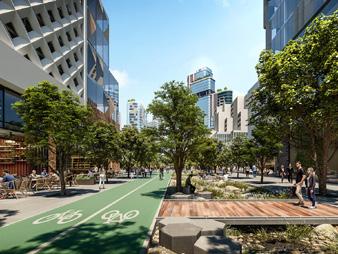
Sustainability
Sustainability is embedded in every element of the plan including transport, building design, water management and open space. Sustainability will be a highly visible and celebrated part of the identity of Arden.
The planning controls set a target of net zero carbon emissions for the entire Arden precinct by 2040 and encourage 6 Star Green Star energy ratings for new developments.
Better building practices will reduce the costs of owning and operating buildings, reduce the cost of expensive future retrofits, and reduce the need to purchase carbon offsets.
The result will be a precinct that achieves a cool, green environment, celebrates water in the landscape, demonstrates world leading building design and has a visible connection with nature and reference to its historical landscape.
Our plans for Arden have been shaped by the insights and priorities of the Arden community. Throughout the planning process we heard from more than 800 community members and
consulted the Traditional Owners, the Wurundjeri Woi Wurrung, which helped ensure our vision and plans for the precinct captured the aspirations of Arden’s diverse community.
These planning controls lift the bar for open space, transport, IWM and sustainability planning, setting a new standard for future urban renewal and infill planning in Melbourne.
The Arden Structure Plan and draft planning scheme amendment are available for public consultation until Monday 11 October. You can see the full suite of planning controls on the Engage Victoria website.
Stuart Moseley, has more than 30 years of experience in planning, urban management and project delivery in the public and private sectors across five Australian state/ territory jurisdictions. Stuart is a reformer and a strong advocate for outstanding urban environments and practical planning solutions. He can be contacted at Stuart.Moseley@vpa.vic.gov.au
kinetica Planning and Urban Design the new generation of trusted experts

10 / VPELA Revue October 2021
Julia Bell / Senior Associate juliab@kinetica.net.au
Alison Milner / Senior Associate alisonm@kinetica.net.au
The Business Priority Projects Standing Advisory Committee

Covid emerged almost in whispers in late December 2019/early January 2020, with most of us wary about it, but thinking, surely it won’t come here. By the end of March 2021, Melbourne was in lockdown and our lives changed forever. This time last year, I am sure no one thought we would still be in lockdown in September 2021, but here we still are.
If someone had told me early to mid last year, I would be chairing a 10 week EES Inquiry in 2020 over videoconference with 6,000 plus submitters, I would have laughed out loud in total disbelief.
However, the planning industry has proven to be incredibly resilient and credit to all involved. How quickly we needed to adapt and to change our way of thinking. Thanks to the COVID-19 Omnibus (Emergency Measures Bill) 2020 introduced by Government in late April last year, online Hearings became lawful for Planning Panels Victoria to convene.
And we haven’t missed a beat. Every Planning Scheme Amendment, Advisory Committee, EES Inquiry and other matters referred to us have been dealt within our normal timeframes.
At the same time, the Planning Group of DELWP was proactively seeking new ways to deal with a range of planning matters. This led to the Minister for Planning appointing the Priority Projects Standing Advisory Committee on 14 June 2020 to provide timely advice on projects referred by the Development Facilitation Program (formerly Building Victoria’s Recovery Taskforce), projects affected by COVID-19 or where the Minister agreed to, or considered, intervention to determine if these projects would deliver acceptable planning outcomes.
The Minister signed Terms of Reference for the Committee on 14 June 2020, and these provide for him to refer a matter to the Committee, accompanied by a letter of referral. Of note:
Clauses 13 and 14 notes the Committee is not expected to carry out additional public notice or referral but may seek the views of any relevant referral authority, responsible authority of government agency.
Clause 17 requires the Committee to a quorum of at least two Members, including one being the Chair or a Deputy Chair. The Committee must produce a written report for the Minister for Planning that provides:
o A short description of the project.
o A short summary and assessment of issues raised in submissions.
o A draft planning permit including relevant conditions from Section 55 referral authorities, or draft planning scheme control depending on the nature of the referral.
o … various other matters
• The Committee is required to submit its report to the Minister for Planning no later than 10 to 20 business days after the completion of the public hearing, or from receipt of the last information filed.
Since its first referral in August 2020, the Committee has now received its 21st referral (as of 10 September 2021). The Committee was reconstituted in January this year following the need to add more members due to its prodigious workload.
The Committee comprises myself, as Lead Chair, all Senior Members as Chairs, a number of Senior Sessionals as Deputy
VPELA Revue October 2021 / 11
Kathy Mitchell AM, Chief Panel Member, Planning Panels Victoria
SAVE THE DATE
Chairs and a range of Sessionals as Members. The Committee is supported by the Senior Project Manager (currently, Andrea Harwood who will be at Minter Ellison Lawyers by the time this article is published) and Georgia Thomas, Project Officer of PPV.
When a referral is formally received by letter from the Minister, it is triaged by me, and the Project team where we determine who should chair it, the extent of expertise required, and relevant members. They are allocated on the basis of immediate availability, expertise and not having any conflicts of interest. Most matters are constituted with two members, sometimes three.
The range of matters referred are VCAT call-ins and draft Planning Scheme Amendments relating to various housing proposals in metropolitan Melbourne and regional Victoria, office and commercial development, hospital redevelopments, road issues and retail developments. One matter was a significant tourism proposal in regional Victoria.
These have been convened by roundtables (with some taking half to one day) focussing on key issues in dispute/or structured by key issue, on the papers and some with a Hearing. All reports have been submitted on or before time.
Of the matters that have been resolved, seven have been approved by the Minister, consistent with the Committee’s recommendation. Three matters have been refused by the Minister, also consistent with the Committee’s recommendations. Five remain under consideration post submission of the report. Currently, the Committee is actively considering six referrals.
Finishing where this article started, we are always asked about in person Hearings. Of course, that is totally dependent on advice from the Victorian Government and the Chief Health Officer. However, in May and June this year, we managed to convene four matters that were either fully or partly held in person before the Delta variant decided to visit us in Victoria.
One was in Shepparton where Council ran a hybrid process, in that it was in person and live-streamed through web cam with parties able to participate in the hearing remotely. One was for a few days in Bairnsdale where part of the Fingerboards Mineral Sands EES Inquiry allowed for presentations by local submitters in person to it, but without a gallery. This was also live streamed with two-way interaction from parties by videoconference. One was a Directions Hearing for a Priority Project SAC in the PPV Hearing rooms.
The other was a three day case involving Moonee Valley at PPV. I chaired that and I was so happy to see people that I put pen to paper:
The woman from PPV
(with sincere apologies [but no regret] to A B ‘Banjo” Paterson)
There was movement at the station
For the word had passed around
PPV was ready for in-person hearings
After 15 months of virtual lock-down.
Oh, the excitement was truly building!
Long and strong and eager
To get away from the screen
What really could be easier?
Monday dawned bright and beautiful
The room was clean and shiny
The members, the parties and gallery
Were keen to put COVID well behind us.
How nice it was when Barrister O’Farrell
To the tune of ‘Welcome back Kotter’
Started the day with some frivolity
The vibe was getting hotter and hotter.
The Hearing went very well
Even though it was adjourned
No worries thought the Chair
We’ll be back soon for another round.
But alas COVID did come again
Much to our great distress
So back to the screen we go
And again to casual dress.
In our cold and frosty winter
Where we are now working from home
Let’s hope for a quick and safe recovery

As we look forward to being able to roam.
So back at our beloved 1 Spring
Where our rooms remain cold and idle
We will wait for the day to come
When we can welcome your arrival
Kathy Mitchell was appointed Chief Panel Member in 2004 and is a former President of VPELA (2005-2010).
12 / VPELA Revue October 2021
Shadow Minister for Planning Democratic, consultative planning; R.I.P?

Daniel Andrews and the current Victorian government seem set to embark on the most significant, far reaching, and undemocratic change to planning powers for decades.
Powers traditionally held by municipal councils are to be pulledin by central government and allocated, it seems, to yet to be defined panels, with these panels being appointed according to what information is available. This will strip local councils of their historic role of land-use planning within their community. The historic removal of democratic planning powers is all claimed to be necessary for post COVID-19 rebuilding. Of course, everyone wants to see projects advanced to help generate jobs – but what projects? And through what process? There is a huge difference between streamlining timelines and processes, and the wholesale overturning of the state’s history of municipal councils as the responsible planning authority.
It is also clear that the proposed changes being discussed in secret where confidentiality agreements are required (to even begin the discussion) will see third-party appeal rights quashed.
Chief Executive Officers and Chief Council Planners have been told if you want to be briefed and have input on these, you must sign a confidentiality agreement which requires that you not talk about these matters publicly, even with your elected Council. It is extraordinary and has an authoritarian feel about it. Why aren’t the details of these seminal changes being debated openly and honestly? The community have a right to know that the state government plans to cut them and their council out of their historic position of control of land-use planning in their local community.
But despite the Planning Minister and DEWLPs secretive approach, details are leaking out, many Councillors are now deeply concerned.
A succession of planning amendments has stripped powers, piecemeal, from Councils and communities, through a relentless chipping away at the role of Councils as the responsible authority and from the democratic rights of communities. What we are seeing is an ‘assault on democracy’ through a slew of planning amendments that remove powers from local Councils and redistribute these powers to a centralised and unelected planning body.
On a broad front, the Andrews Labor government is stripping away decision-making from local Councils and communities. In a slew of new planning amendments, consultation requirements and third-party appeal rights are being stripped away in favour of an unelected and ill-defined centralised planning body.
David Davis MLA
Am VC198 exempts consultation requirements and reporting for Major Roads Projects (Clause 52.35) and Rail Projects (Clause 52.36).
Am VC170 allows for pre-commencement requirements to be “varied or waived by the Planning Minister” (52.03-6) for activities under the Level Crossing Removal Project.
If these amendments did not go far enough, Am VC194 simply calls-in the planning authority with no requirement for public consultation or consultation with local government –the representative voice of our local communities – for any ‘State project’. Under Planning Am VC194, Daniel Andrews and Minister for Planning, Richard Wynne, are silencing the Victorian public and granting themselves the excessive power to approve State infrastructure projects without the formalised process of a planning permit application. Most recently, Am VC196 has exempted extractive industry projects from “the notice requirements of section 52(1)(a), (b) and (d), the decision requirements of section 64(1), (2), and (3) and the review rights of section 82(1) of the Act”.
On social and public housing, recent amendments Am VC187 and Am VC190 strip planning powers from Councils. While I strongly support more social housing, it is critical that local democracy is protected, and that local Councils play a role in determining the suitability of proposed projects for their local area. In Hawthorn at Bills Street, a social housing development that is completely out of character has been approved by the Andrews Labor Government against Council and community wishes.
This is a straight grab for power by Daniel Andrews, his government and the Planning Minister. The Andrews Labor government’s consultation process has been both secretive and entirely unsatisfactory in implementing their new planning agenda. We all support expedited planning processes, but we do not support planning processes that mean cutting out Councils and local communities and granting planning power to an unelected body. Communities have got a right to know about their future and a right to be involved in planning their future. Land use is central to what councils and communities do in planning the future of their local area.
The community I think will want to see smooth processes, but they will not want to see that they have got no say in the future of their area. I say this is a shocking and dictatorial set of decisions that are being made. I support expedited planning process; I do not support the destruction of the checks and balances that ensure robust planning decisions are made.
VPELA Revue October 2021 / 13
The Business Local and State Government, efficient, effective… and fit for the 21st century?
I have seen the best and the worst of community politics. I have witnessed the diversity of needs across Victoria, observed differing management styles, seen innovation and obscuration, I have been enthused and proud of some councils and horrified and ashamed of others.
From 1987 to 2016, I was involved in local government first as a councillor and Mayor of Hawthorn, a board member and first female treasurer of the Municipal Association of Victoria, a Commissioner at Brimbank, a Member of The Councillor Conduct Panel and again at Brimbank as an Administrator, same role as Commissioner, different times, different names.
As a thirty-something in 1987 when I was elected as a councillor to the City of Hawthorn, it had a population of 32,000 and was managed by a duopoly, the Town Clerk and the City Engineer. I was fresh, enthusiastic, a mother of 5, a former History and Phys Ed teacher, a retailer and knew nothing about the policies, processes, platforms and passions imbedded in community representation.
I quickly learned about legislation, leachate, zones, regulations, budgets, and bastardry. It was a hell of a ride. Local government at its best, is a robust representation of conflicting needs and desires, it implements strong policies that give clarity of direction and represents the community, whilst respecting the professionalism of the officers. At its worst, it is driven by party politics, power hungry or weak councillors and officers who acquiesce to pressure, creating confusion and lack of trust with the residents, ratepayers, and developers.
When I was elected, I received two pieces of advice from an eminent gentleman. The first: If you get a very long report, the officer doesn’t want you to know what is going on. And, the second…if State Government has a problem, local government will be on the front page. Both were very accurate pieces of advice.
The broad range of my experiences has given me a perspective and some insights into how all our governments operate.
There is too much duplication. There is more intrusion, than collaboration, little trust between spheres, and lack of coordination and cooperation. An enormous amount of wastage occurs with the difficulties in the intertwined State and local systems that make it costly to introduce change to adapt to future needs. This provides poor protection of our heritage as well as presenting obstacles that stifle development. And anything innovative is usually met with crushing resistance from the naysayers, often with party politics taking advantage of a contentious issue.
My conundrum rests with the conflicts in how best to achieve good community management.
Jane Nathan, former President, VPELA

The benefits gained from the financial, social, environmental, and cultural wellbeing of local communities escalating to State and national level is apparent, but which system? The democratic model, when it is ‘of the people, for the people, and by the people’, works. But the truth is, that in the twenty first century, many local governments have been impregnated with party machinery politics and minority groups.
Labor had tried to amalgamate councils in the mid 80s and couldn’t pull it off. But in 1994, with a Liberal government controlling both houses, amalgamation occurred. Councils were progressively reduced from 210 down to 78. It was stressed that municipalities were archaic, costly, with largely self-serving bureaucracies. The amalgamations, it was said, would create efficient, effective and less costly local governments.
Very few Commissioners of the 240 appointed had local government experience. It was a huge learning curve for them. The majority grew into the role, but there were some disasters. Commissioners as well as councillors need to be able to read and write, be numerate, problem solvers, open minded, good communicators and respectful of dissenting opinions. The professionals should have the diversity of skills needed to feed the decision making.
In a democracy, the electors should be the judge of their representatives unless laws are broken. Satisfaction with their leaders should be left to the electors as it is with State and Federal Governments. Local voters need to understand their responsibility to both assess and expect good management with the right to scrutinise their representatives; taking their right to vote seriously. Could it be that with the larger councils, the electors feel disenfranchised and leave the State Government to manage misbehaviour?
With the appointment of Commissioners, a very different model was introduced. They were appointed by the State Government. There was very little oversight apart from the clear directions to put all councils on the same rate base, reduce staff, and shift delivery costs from government funding to ‘user pays’.
Before amalgamations, there were constructive discussions in local government, both positive and negative, about the consequences of the physical restructure. There was no debate regarding representation models.
Would Victoria benefit by reducing the number of councils and therefore increasing councils geographic and population size, introducing more efficient management?
Or would it be better to stay with smaller councils and introduce more effective management, using compulsory, competitive tendering, and introduce resource-sharing across existing councils, covering both people and services, from depots, garbage collection, strategic and statutory planning, and community services to health.
14 / VPELA Revue October 2021
I was concerned that there was a danger that the strategic planning benefits of more regionally focussed councils could be outweighed by factors of the larger population and land mass. This might lead to the removal of local involvement and lack of recognition of diverse community needs; with political party machinery controlling elections and therefore councils, combined with the possibility of having all the councillors turned over every four years, leaving greater power with the council professionals.
The introduction of postal voting (which is much easier) has removed the opportunity for community candidates to get elected because ‘Money’, like ‘presidential elections’ can control the outcome.
With the structural changes and increase in size, we need to evaluate whether restructured local government is still democratic? Are its planning decisions strategic, or susceptible to pressure? Can part-time councillors really manage the workload? Are the councils (most much larger than a local State Electorate), in need of an overhaul, to either return them to true community government, or would it be better to be administered and if so, how would administrators be appointed?
One of the major benefits of truly local government is its role as a social and cultural connector. It recognises the personalities of differing geographical areas such as Brimbank and Boroondara and the needs of its constituents. True local government allows for women to play a constructive role in the decision-making process. The ability for women to take on a community leadership role as a councillor or an officer, has given municipalities an advantage in policy development. In community decision making, it is vital to be connected and close to the issues. There is evidence to show that better decisions are made and a more inclusive culture exists when women are at the decision-making table. It is also said that when a woman stands, she has a 10% advantage as many communities respect the woman’s ability to “read” the community.
The reality is that local government is not well understood. While most local governments deliver over 100 services to the community (from the very young to the more mature), 80% of people dealing with it are seeking/dealing with planning applications. That is an emotive time, encountering a drawn out process that can be easily interrupted by minority groups.
The Underwood Committee, 2011, heard consistently that it was the State Government’s lack of clarity and accountability that was a major problem in planning. The Sweeny Report in the early 1990s concluded that the majority of people would get rid of State Government, considering that local government was serving the community needs and was seen as more accountable.
The recommendations about cost shifting, especially from State to local government, that the Hawker Report investigated in 2007, need to be addressed. The report stated that duplication and lack of coordination wasted $20 billion a year. I dread to think what that figure is now. We, for the sake of our children, must question such wastage and ask, is this something we can continue to afford? Is it fair that the 20% of funding for libraries from your rates before amalgamation (as it was seen as a State Government responsibility), has risen to 80%? So, in effect, you are being taxed twice; and what is the State Government doing with the ‘Library tax windfall’?
Cost shifting, combined with the rate capping, has reduced the capital infrastructure spend on both human and physical infrastructure in communities. This is causing an ongoing reduction in services from the services to the very young, to the elderly.
Maybe we could reduce State Government departments, leave the politicking at that level and beef up local government?
For the country’s future, it is time we sorted out the roles and responsibilities of each level of government and who is best to deliver those services and respond to the people’s needs; culturally, environmentally, physically, socially and economically. Why, when local government has an immunisation program already in place, did the Federal Government develop a duplicate system?
In 1986, The Ottawa Charter for integrated health planning was taken up here as ILAP, Integrated Local Area Planning in Australia. I was privileged to Chair the State Committee in the early 1990s with much enthusiasm and support from Federal and State Governments. ILAP aimed to coordinate, to integrate, and to allow for broad participation across differing sectors. It was aimed to achieve inclusive decision-making whilst acknowledging the roles and responsibilities of governments.
I was also involved with the SLEC Committee looking at Strengthening Local Economic Communities with State and Federal experts working together to increase local spending across commercial, industrial, and retail by using local businesses – a great example of governments working together rather than duplicating public services.
The real question that needs open and honest debate has been suggested by many politicians after they have retired. This is the need to define the roles and responsibilities of Federal, State and local governments. Voters need to be educated to clearly understand the differences in electing a person to lead a local community, and state representation. We need to define which government levels are best at doing what, to deliver in a competitive world environment, giving clarity, allowing for innovation and lifting productivity across Australia.
We could start by reviewing and evaluating how successful amalgamations were during the Commissioner’s time of management? How efficient and effective are our present councils led by councillors, compared to how effective and accountable are the councils who have been under administration?
We need to decide whether we are capable of developing systems and processes that allow for electing true community representation, or is an administration management model more accountable to the community?
The criteria would be easily established, but are we mature enough to accept the results?
Jane Nathan has been a true champion within VPELA, having served as President of VPELA in 1997-2000, and then as Editor of VPELA newsletter up to 2014, (now titled VPELA Revue). Jane is a recipient of the Richard J Evans award.
VPELA Revue October 2021 / 15
People From ‘A Resilient Career’ program: Reflections

remember suggesting to her that it was a good time to have a rethink about what she wanted to do with her life (I thought she had a great eye for design and should re-train as an interior designer!). She never did do that and instead continued to struggle with anxiety and her confidence.
Maria -
As the immediacy of her death passed, I often reflected on her loss and in doing so, reflected on how hard it must have been to get her career up and running again after taking time off for parental leave.
VPELA recently launched a new program called “A Resilient Career” sponsored by Maddocks and led by experienced career coaches from Thrive Leadership. The program is designed to support and assist women or men who are in their mid-career period and looking to re-establish their career after a parental leave or other break, or who are seeking to redefine their next steps towards their career objectives by re-assessing, re-booting and re-launching. The program began in September with our first group of 14 participants.
The VPELA program “A Resilient Career” is sponsored by Maddocks and led by Thrive Leadership. Maria Marshall of Maddocks and Meg Lee of Hall & Wilcox welcomed the participants with some reflections about the genesis of the program and reflections on their own career journeys. Some excerpts of their comments are below.
Maria -
I suspect we have all had a few of those moments during the pandemic. Those moments you realise that this is not a drill, but it is all too real; that working from home and isolated from colleagues and mentors is here to stay for the foreseeable future. And then there’s those moments that strike dread in you. For me, two of those moments in the last 18 months have been hearing of the loss of Phil Bisset and Annabel Viner, both VPELA members and valued members of our planning law community.
Annabel Viner had been a former Senior Associate in my team at Maddocks. She was the brightest of sparks and a loved member of our team. She had 2 young children and had taken a 5 year career break after her second child. She came to Maddocks as she restarted her career. She was an excellent lawyer and a warm and engaging person. Sometimes the cut and thrust of law firms didn’t suit her. I was disappointed when she left our team and very sad to hear of her death.
Meg -
One of the things that Annabel and I often talked about was her career and how she struggled to get back into the planning & environment industry after having a 5 year break after having her second child. I
As young woman lawyer, I was fortunate to have some amazing mentors who have encouraged me, helped me survive what I felt to be impossible, and the importance of perspective and reflection. I’ve thought often of a conversation I had with Helen Gibson at a VPELA function about career being a marathon and not a sprint.
Meg -
In my own career journey, I have been lucky to have had firms that have put me on leadership programs. I have also had some fabulous mentors; both formal and informal, many of whom I have met through VPELA. They have been invaluable sounding boards and coaches at various times in my career when I have faced challenges or decision points about moving firms or progressing to Partner.
Maria -
As a Partner at Maddocks, I hope I have been able to play a small part in the success of many lawyers, planners, and others with whom my path has crossed over the years. I know I get enormous joy from the success of others with whom I have worked.

As a mentor and supervisor, I’ve watched women and men struggle with their career trajectory. I’ve seen women return from often multiple stints of parental leave. Sometimes they fly, sometimes

16 / VPELA Revue October 2021
Meg Lee, Partner, Hall & Wilcox and Maria Marshall, Partner, Maddocks Lawyers
they struggle. I hope that over my years as a Partner and team leader we have got better at helping lawyers through these difficult mid-career years. Mid-career years can be grinding and can be made more complicated by time taken for parental leave, even if that leave brings joy as well.
Since her death I have often thought about Annabel (and her two daughters). I wanted to find a positive way to honour Annabel’s life and to find a way for her memory to live on and to help others who are in a stage of life where they are struggling with their career path. I am so glad that I was able to inspire Meg Lee and VPELA to tailor this program to enable participants to assess their skills and reframe career objectives.
Meg -
It has been a real privilege to read each of your applications to participate in this program and I thank you for the honesty and vulnerability that you showed in putting yourselves out there. We are just delighted that it seemed to hit the right note for you all, for a variety of reasons, and we look forward to hearing from you all at the end of the program about what you learned about yourselves and what you hope to achieve going forward.
The first group of 14 participants have begun their journey with a self-skills assessment and a workshop. Over the next month, they will have one-on-one mentoring and then participate in a second workshop, combining the theory from the first workshop, with their insights into their skills and career interests, aligning their career objectives and developing their career materials. At the end of the program the participants will join with the VPELA Board for a celebration.
The Board has approved funding and a commitment to run the program on an annual basis. We look forward to many more of our VPELA members being able to participate in future years.
The Resilient Career Program is an initiative that was put in place by the VPELA Board as a direct response to the many career challenges people experience in their working lives. The pandemic and the resulting struggle by many members to juggle home commitments and work highlighted the need for a program that would help members clarify and achieve their career objectives. It is our intention to run the program again in 2022 and all members will be eligible to apply for this program. Details will be available in our March edition.
VPELA Revue October 2021 / 17
The Business Suburban Rail Loop: an extraordinary new planning authority
On 16 September 2021, the Victorian Parliament passed the Suburban Rail Loop Bill 2021 providing infrastructure build powers but also extraordinary planning powers to the Suburban Rail Loop (SRL) Authority. These include direct planning authority status, veto power over amendments by other authorities in SRL planning areas, and purported exemptions from parliamentary revocation and procedural defect appeals.
There is always a need to ensure infrastructure projects within a government’s mandate are facilitated through appropriate legislative and regulatory change. But what does the legislation mean for planning in suburban Melbourne?
New infrastructure and urban growth in Melbourne
Infrastructure has always paved the way for cities to grow including Melbourne. Through much of Melbourne’s history planning has followed major infrastructure projects – coming in to manage and facilitate the growth enabled by the infrastructure. From the establishment of its ports and first grid street layout to the largely private rail networks of the 19th century and the development of an enormous freeway network in the 20th century, the establishment of major movement infrastructure preceded planning for the growth around it.
When, by the mid-20th century, mechanical personal transport, ‘the car’, was being acquired at a rate like the rate of home
Matt
broadband take-up today, the MMBW 1954 plan cobbled together city bypasses from Chapel Street Windsor via King Street to Royal Parade and from Hoddle Street via Royal Park to Flemington Road.
However, it wasn’t until the late 1960s freeway network plan, coupled with the enormous Thompson Dam, the establishment and protection of Tullamarine Airport, and planning for the city loop rail project, that the MMBW was able to produce Planning Policies for Metropolitan Melbourne (1971) with its decades of urban land supply leveraging off these assets.
Since then, metropolitan plans have focused largely on land use with existing infrastructure as a given – with its use to be maximised through planning at the local level, i.e. activity centre development on rail nodes and industrial expansion along freeways.
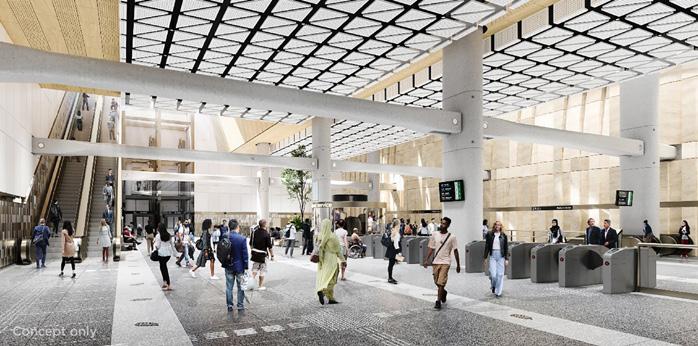
The current infrastructure boom
In this century we have built up to an infrastructure crescendo in Victoria. Early efforts included the desalination plant, Southern Cross Station, the regional rail expansion and the planned outer metropolitan transport corridor. In this decade we have seen major train line expansions through level crossing removal, new electrifications and extensions, as well as coming close to completing the freeway network and the under-construction Metro Stage 1.

18 / VPELA Revue October 2021
Rogers, BMDA Development Advisory
Concept Monash Station render concourse (source: SRLA)
None of these projects have been explicitly accompanied by planning strategies – attempts to integrate growth outcomes in level crossing removals have been specific to the sites under construction and, in the case of the proposed development site at Ormond, thwarted by the parliament. Perhaps the actual crescendo of this current infrastructure boom is the Suburban Rail Loop.
Again, this project was not part of any planning strategy – the projects stand on their own with the functional benefits of the project, i.e. saving travel time, creating new jobs and so on. The questions in a planner’s mind might be: what are people travelling to? how many and what type of jobs? where are we going to accommodate the resulting growth?
On one view, the SRL was retrofitted to our current metropolitan plan. On another it complements and could give real teeth to Plan Melbourne’s cities-within-a-city theme or ‘polycentric’ model, and respond to the much-discussed ‘missing middle’ issue in Melbourne planning over the past decade. No matter its relationship to strategy and policy – it will have huge impacts on planning in Melbourne. So how will this be managed?
The Suburban Rail Loop Act 2021
On 7 September 2021 the government provided the first public clue by asking the parliament to give:
The transport minister power to designate Suburban Rail Loop planning areas (SRL planning areas) (Part 3);
The Premier power to declare infrastructure related Suburban Rail Loop projects provided the development isn’t prohibited by a planning scheme, providing automatic approval under the Major Transport Projects Facilitation Act (Part 4); and
The newly created SRL Authority the conventional array of powers to enable it to carry out its infrastructure building work.
More importantly for planning the bill substantially changes the Planning and Environment Act by:
Granting the SRL Authority direct planning authority powers in SRL planning areas; section 9A; Enabling the planning minister to exempt the SRL Authority from the exhibition and notice requirements for planning scheme amendment; new subsection 20(6);
Preventing the planning minister from authorising amendments of other authorities in SRL planning areas without SRL Authority consent; section 8A(6A);
Requiring the planning minister to consult the SRL Authority before appointing advisory committees and panels for amendments in SRL planning areas; sections 151 and 153; Preventing the parliament from revoking a SRL Authority amendment that has been approved by the planning minister; new section 38(6); and Removing procedural defect appeals to the Tribunal; new section 39(8).
On 16 September 2021, Parliament’s upper house passed the bill without amendment.
Now for the hard work: planning alongside the infrastructure and communities
The planning powers are substantial for a transport minister directed body – rivalling, and in some cases surpassing, the planning minister’s powers. Public commentary from the State opposition and local authorities displays apprehension about the potential use of the extensive power bestowed on the SRL Authority – similar apprehension about a central, expedited planning model led to the difficulties note above in relation to development around a level crossing removal. An entirely new rail line is anticipated to trigger a great deal more development than the odd pad site next to a rail station.
The test of the new authority will be the way in which it puts these sweeping powers to work. Much is to be done to reassure the dizzying array of authorities, councils, interest groups, communities and governments that these powers will be well used over the coming decades. Directions on the tools and mechanisms the authority will seek to deploy in the planning arena are keenly awaited.
All in all, it is positive to see that local planning around the new infrastructure is, at least in the parliament’s mind, intended to be carried out alongside the new build. Something not often seen at this scale in Melbourne. It is now up to the SRL Authority to bring this model to life.
Matt Rogers is an Associate at BMDA Development Advisory, has practiced as a qualified town planner in Victoria for 20 years and will complete his Bachelor of Laws degree in 2022. e: matt.rogers@bmda.com.au
VPELA Revue October 2021 / 19
Places Clarkefield: Dreaming big for a small new township
In one sense it almost seems too good to be true. Clarkefield is a largely undeveloped hamlet on a train line, just 40 minutes from the centre of Melbourne, and at the gateway to the Macedon Ranges, and already zoned for a township.
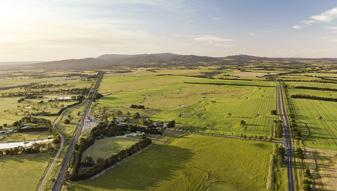
The township includes a small collection of privately held residences, a heritage hotel and horse stables, a sporting field and community facilities, and a disused school. Sadly, a number of these buildings have been in a slow decline for several years.
There is currently no reticulated sewerage or water supply in the town, and this has prevented the growth of the township.
The uniqueness and beauty of Clarkefield strikes you to the point you just know there is an opportunity to do something innovative; that this picturesque location deserves something different. At APD Projects we admit that we have been willing our stakeholders in the Macedon Ranges to suspend their judgement of property developers and take a fresh look at what we are proposing at Clarkefield that will set new benchmarks in the way townships are created.
Three key initiatives
Brad Paddon, Director, APD Projects

We are now three years into planning a future Clarkefield. Once we had commenced on a different pathway, it has been hard to stop. I could talk here about our plan for a connected walkable 20-minute neighbourhood; how we have linked in the natural surrounds and heritage features of the town, and how we solved the water reticulation issues with more sustainable outcomes.
The bottom line, however, is that we propose that one of Victoria’s oldest settlements will become one of its most sustainable ones, and one of the first in the nation to be designed around responding to climate change.
APD plans to take responsibility for the carbon emissions embedded in the proposed infrastructure at a revitalised Clarkefield township. When new residents of Clarkefield enjoy their walkable township, they will be treading on specially sourced low carbon concrete and asphalt.
With the surplus embedded carbon emissions, we propose to set them to zero by growing a dedicated and diversified living forest asset. Ultimately APD sees a 50 to 100-hectare forest being developed; potentially nearby, to offset construction emissions, and which possibly could be used for open space.
The second initiative is to design Clarkefield so it can support low carbon living for its residents. Two critical pillars are being put in place for residents to reduce their carbon footprint.
First, will be solar power generated on-site. Ultimately Clarkefield will have a solar farm dedicated to its residents. Initial housing in the area will also have the option for solar panels ahead of any larger development for the solar farm.
20 / VPELA Revue October 2021
Clarkefield
Every house will be all-electric to enable the use of on-site renewable energy and at least 7-star rated for its energy efficiency. From our studies, we have settled on this rating as the optimum for reduced heating and cooling needs in the location, while also minimising build costs.
We have also committed to the inclusion of long-term affordable housing at a percentage below market rent. While allocating a proportion of housing to affordable stock is not new, APD plans to do this under a build to rent model (or PRADS, Permanent Rental Affordability Development Solution) created by Housing
All Australians. We are passionate about providing for a diversity of housing options within the new communities we create, particularly ensuring opportunities for low to moderate income earners in the Macedon Ranges which suffers from both a lack of housing diversity and affordability.
Progress towards a Development Plan
APD is initially planning between 350 and 450 lots on the 26 hectares of land in Clarkefield current zoned Township under the Macedon Ranges Planning Scheme. This land is subject to a Development Plan Overlay which requires the preparation of a ‘Development Plan’. The commencement of this statutory process is only phase 1 of a far more ambitious plan to commence the planning work required to define the urban expansion strategy for Clarkefield. We recognise that planning for new development in Macedon Ranges must respect the character and environmental attributes that exist in this highly valued part of Victoria.
It was therefore important to us that we engage early with the community to ensure time to incorporate their views whilst also ensuring that our plan fully aligns with the State and Local Government’s vision articulated within the Macedon Ranges Statement of Planning Policy.
In our engagement with the community, we have sought to incorporate into our future plans the aspirations and visions of those currently living in Macedon Ranges. The project received plenty of public interest of course, and we are pleased to say most of it neutral to positive. The project is being viewed as having a refreshing vision. This has given us confidence about our direction.
The vision for a carbon-neutral Clarkefield has not been a light undertaking. It has required a strong commitment to the cause, a new way of thinking, an additional suite of advisers, and at times, ‘deep pockets’ and patience. We believe, however, that it will certainly be worth it, as it will raise the bar in sustainability and 20-minute neighbourhoods that will benefit generations to come.
APD Projects is a Melbourne-based developer and manager, specialising in landmark residential and retail property. Their approach to contemporary development delivers better places today, for thriving communities tomorrow. More information about Clarkefield can be found at https://shapeclarkefield.com.au/
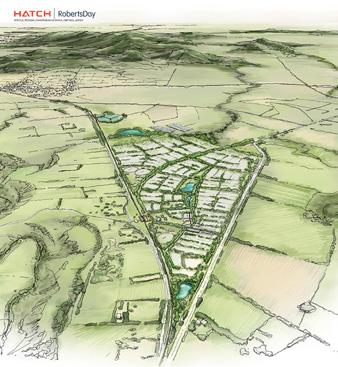
VPELA Revue October 2021 / 21
Clarkefield Sketch – Macedon view.
The Business Legal World
Garden Area matters
Priestley v Horsham RCC (Red Dot) [2021]
VCAT 639
In this matter, the Tribunal considered whether the garden area requirement for a subdivision in the General Residential Zone was a mandatory requirement and whether a permit condition is sufficient to meet that requirement. The Tribunal held that the garden area requirement for a subdivision permit is mandatory, and must be complied with in the planning permit application (as opposed to a condition of the permit).
Clause 32.08-3 provides that “an application to subdivide land… must ensure that each vacant lot created less than 400 square metres contains at least 25 percent as garden area.” The permit applicant applied to subdivide a property into 4 vacant lots of approximately 300 square metres, enlivening the clause 32.08-3 minimum garden area requirement.
Council granted a permit for the subdivision with a permit condition that the each lot of the subdivision must include a minimum of 25 percent as garden area. The Tribunal was to determine whether the garden area requirement was mandatory and if so, whether a permit condition was sufficient to meet the requirement.
Is the garden area requirement for a subdivision permit mandatory?
The Tribunal noted that clause 32.08-3 is drafted differently to another garden area requirement that applies to an application to construct a dwelling under clause 32.08-4. The dwelling garden area requirement provides that “an application ... must provide ...” but the subdivision garden area requirement provides that ‘”an application ... must ensure that ...”. The Tribunal has considered on many occasions that the garden area requirement for a dwelling permit under clause 32.08-4 is mandatory. In this matter, the Tribunal held that even though there is a different construction between the clauses, both are directive and mandatory in drafting. Therefore, the garden area requirement for a subdivision permit is also mandatory.
Can the garden area requirement for a subdivision permit be satisfied by a permit condition?
In Clayton Gardens Pty Ltd v Monash CC [2019] VCAT 1138 the Tribunal held the garden area requirement must be met in the application for a dwelling and cannot be met by condition of the permit. The Tribunal engaged in an exercise of statutory interpretation and held that as both garden requirements are mandatory, they both evidence that the requirement must be met prior to granting of the permit and be satisfied in the application. As the Council included the permit condition that the proposal must meet the garden area requirement, it can be implied that
Tess Kerridge, Senior Associate, Holding Redlich

Council decided that the application did not itself comply with the requirement.
As the clause 32.08-3 garden area requirement is mandatory and must be complied with in the application, not via a permit condition, the Tribunal set aside the Council’s decision to grant the subdivision permit and remitted the permit application for reconsideration.
Cl. 52.31 Local government projects; ‘before and after’
Yarrawonga Community Action Group Inc v Moira SC (Red Dot) [2021] VCAT 655
Here, the Tribunal considered the operation of Clause 52.31 in all planning schemes on review applications made before the operation of the clause. The Tribunal held that because the application for review was made prior to the commencement of 52.31, the application was validly made.
The Yarrawonga Community Action Group Inc. applied to the Tribunal under section 82 of the Planning and Environment Act 1987 (Act) to review Moira Shire Council’s decision to issue a notice of decision to grant a permit to demolish the Yarrawonga Community Hall and construct a new library and community centre. Moira Shire Council, as the permit applicant, applied to the Tribunal to summarily dismiss the Action Group’s application, having regard to the effect of clause 52.31.
Clause 52.31 provides that applications to develop land by or on behalf of a municipal council are exempt from the notice requirements, decision requirements and, relevantly, review rights by objectors under section 82 of the Act. Clause 52.31 was introduced on 25 March 2021 to “facilitate the timely delivery of ... local government infrastructure projects and reduce delays in planning approval processes to unlock construction sector activity and position Victoria for an early economic recovery from the impact of the coronavirus (COVID-19) pandemic.” Council sought to rely on this clause to summarily dismiss the application for review. However, the application for review was submitted in 2020, well before clause 52.31 came into operation.
The Tribunal noted that the proposal likely does fall within the exception to review rights provided by clause 52.31. However, the Tribunal referred to Wittenbach v Cardinia SC [2017] VCAT 793 which established that a valid application lodged under section 82 of the Act is a right accrued under a planning scheme and, as such, an accrued right is not affected by a later amendment to a planning scheme unless “the contrary intention expressly appears” to remove that accrued review right. The Tribunal held that the principle in Wittenbach applies, and in this case, clause 52.31 does not include any express intention contrary to
22 / VPELA Revue October 2021
the protection of a valid application lodged under section 82 of the Act.


The Tribunal noted the nuanced difference between the Wittenbach principle, that accrued review rights are protected from later amendments to a planning scheme, and the Ungar principle. The Ungar principle from Ungar v City of Malvern [1979] VicRp 25 provides that a decision on a permit application by a responsible authority (or the Tribunal on review) must be made in accordance with a planning scheme as it exists when the decision is made. As an accrued right, review rights are “locked in” when an application for review is made, irrespective of further updates. This is because the Ungar principle only applies to provisions of the planning scheme that are applied in making a decision on a permit, as opposed to review rights which are not involved in the decision making process under a planning scheme.
As clause 52.31 did not show an intention to prevent accrued review rights from being displaced, pursuant to the Wittenbach principle, the exemption to review rights under clause 52.31 only operates on review applications made after commencement. As the review application in the present case was made before clause 52.31 commenced, the Tribunal held that the accrued review right remains and Council’s application for dismissal of the application “must fail”.
Existing use rights lost
Brooks
v Stonnington CC (Red Dot) [2021]
VCAT 930
In this proceeding, the Tribunal considered whether existing use rights for land are lost on demolition of all buildings on that land. The Tribunal held that demolishing more than 50% of a building extinguishes existing use rights under clause 63.10.
The land in this matter acquired existing use rights for retail premises, which is a prohibited use in the General Residential Zone. The applicants proposed to wholly demolish the single storey building on the land and construct a six-storey mixed use building in which the retail use would continue. Council refused to grant a permit to construct the new building on various grounds, including that an existing use right is extinguished where a building is wholly demolished.
The Tribunal held that there were existing use rights in the present case, and that the matter turned on the question of whether complete demolition of buildings on land with existing use rights results in a loss of those rights. The question of complete demolition extinguishing existing use rights is not settled. Earlier decisions have held that complete demolition does result in a loss of existing use rights, with later decisions having held the opposite.
Clause 63.10 of the Victorian Planning Provisions provides that “if at least 50 percent of the gross floor area of a building or at least 50 percent of the area of any works is damaged or destroyed so that the use cannot continue without the building or works being reconstructed, the land must be used in conformity with this scheme, unless a permit is granted to continue the use.” Essentially, this means existing use rights are extinguished where a building is mostly damaged or destroyed. Whether demolition also leads to existing use rights being extinguished under this provision turns on whether ‘damage’ and ‘destruction’
connotes an action that is by ‘accident’ and excludes deliberate demolition.

The Tribunal noted previous decisions, however, undertook a fresh exercise in statutory interpretation to determine the meaning behind ‘destroy’ and ‘destruction’ which are not defined in clause 63.10 or in the planning scheme.
The plain meaning of destroy has a variety of meanings but expressly includes demolition in the Macquarie Dictionary. Further, the Tribunal noted difficulties in excluding demolition for the purposes of clause 63.10. For example, significant damage or destruction of a building that requires it to be reconstructed to continue the existing use. That might involve demolition of the damaged or destroyed portion of the building before it could be reconstructed. In practice, the Tribunal preferred the certainty and simplicity of applying the plain meaning of destruction as including demolition.
The Tribunal also noted the principle in City of Nunawading v Harrington [1985] VicRp 64 that “in the town planning field, statutory provisions designed to protect and preserve existing rights should be as liberally construed as the language in its context allows…” However, a construction that includes demolition as a trigger for extinguishing existing use rights promotes the implied purpose of ending an existing use right if the buildings in which the use is carried out are substantially damaged or destroyed and to bring existing uses into compliance with the current planning scheme.
The Tribunal held that demolishing more than 50% of a building extinguishes existing use rights under clause 63.10. In the present case permission is required under clause 63.10 to continue to use the land for retail premises following demolition of existing buildings. The Tribunal noted the difficulty in interpreting this clause and forwarded its decision to the Minister for Planning to consider whether any amendment to clause 63.10 is warranted.
VPELA Revue October 2021 / 23
SAVE THE DATE! VPELA CHRISTMAS PARTY 2021 7 December Trunk Exhibition Street, Melbourne Proudly sponsored by Mark this date in your diary now! This event will be confirmed closer to the date.
The Fast Lane with Henry Turnbull
Planning for electric vehicles
I have previously written about the need to plan for charging of electric vehicles (EVs) in residential developments by the provision of electrical infrastructure to service parking bays. There are however, much broader considerations with the with the rise of EVs within the vehicle fleet.
Around the world, car manufacturers are shifting from internal combustion engines (ICE) to electric engines. Major automakers such as Audi, BMW, VW, Volvo, GM and Toyota have all set targets of between 2030 – 2035 to stop producing vehicles with ICEs. Jaguar will stop in 2025!
As EV technology advances, the major detractors of charging time and range are being addressed. Modern “quick charging” can be as short as 20 minutes, depending on the rating of the charging unit. Improved batteries are giving driving ranges of 600 - 800 kms for some models.
So what are the implications as the proportion of EVs grows within the fleet? Charging is the most obvious.
The most efficient charge for the everyday motorist is the trickle charge through a standard domestic outlet. Generally, this will work well for those with a formal garage or basement parking space. There will however, be a demand for charging stations at work for those who cannot charge at home. The long duration of stay makes daytime charging viable. So again, we will need to provide sufficient electrical infrastructure in commercial carparks and office towers to facilitate charging.
Commercial charging stations will of course be part of the picture. Quick charge facilities will be available at service stations but there will be a major difference – the time taken to fill up. If one imagines that it will take about 20 times as long to fill up an EV compared to an ICE vehicle, then one could expect to have a much larger forecourt requiring a much larger site.
Henry Turnbull, Consulting Traffic Engineer
We might expect that EVs used primarily for commuting will not need to use commercial facilities in the same way ICE vehicles do but nevertheless, there will be charging demands. Smaller existing service stations without cafe or lounge type facilities are unlikely to be able to service EVs.
Major service stations and freeway service centres are likely to be able to accommodate EVs as well as provide the facilities to occupy the motorist while charging is taking place. Faster charging will cost a premium so many customers will not be in a rush.
With many regional and inter-capital trips the norm, we can expect purpose built facilities either adjacent to existing service centres or as new developments. In the UK last December, GRIDSERVE opened the first of a planned 100 electric forecourts. The photo above is of the Braintree facility in Essex.
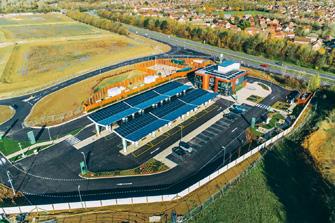
The EV revolution is not as far away as one might think. Private cars make up about 10% of greenhouse gas emissions so policies to encourage the change to EVs are well regarded. The Victoria Government supports the purchase of EVs or hydrogenelectric vehicles with an incentive of up to $3,000 for EVs priced under $68,740. This incentive is somewhat soured however, by the introduction of a road user charge of 2.5 cents/km for EVs (2.0 cents/km for plug-in hybrid vehicles) from the 1st July 2021.
In NSW, there is legislation pending for a similar cash incentive to purchase an EV, together with a stamp duty exemption proposed to operate retrospectively from 1st September, 2021. In Europe, these incentives are already common and can also include free public transport for EV owners as well as free parking, etc.
EVs are coming and we need to be aware of the likely changes as those with older infrastructure try to catch up.
Henry Turnbull is a Consulting Traffic Engineer and a former President VPELA
 (2001-2003)
(2001-2003)
24 / VPELA Revue October 2021
The Business
Michael Pavlidis, Lawyer, Planning & Property Partners

The garden area requirements were introduced by Amendment VC110, gazetted on 27 March 2017. Subsequently, Amendment VC143 was gazetted on 15 May 2018, which, amongst other things, added exemptions to the minimum garden area requirements found within the General Residential Zone (GRZ) and Neighbourhood Residential Zone (NRZ) as introduced by VC110.
VC110 was plainly an attempt by the Victorian Government to save the fading great Aussie dream of owning a home with a backyard – in the words of VC110’s explanatory memorandum, to “improve housing capacity and choice while continuing to protect and respect the openness and character of established urban areas throughout Melbourne and Victoria” (my emphasis). A noble effort, but no doubt a tough gig when one contends with the sky-rocketing value of properties and clear policy directives for greater dwelling density in established areas.
VC143 sought to improve the operation of the minimum garden area requirement by “enabling the garden area to be switched off in the General Residential Zone for areas identified for more intensive residential development to achieve housing diversity and affordability objectives in locations close to jobs and services, urban renewal and strategic redevelopment sites”. Read another way, VC143 could be viewed as conceding that the initial minimum garden area requirement was unintentionally impeding the application of other pressing policies, i.e., the development and supply of diverse and affordable housing.
One of the interesting and arguably ambiguous ways the government loosened the belt of the minimum garden area requirements was to introduce certain exemptions. Specifically, these exemptions can be found in Clause 32.08-4 of the GRZ and 32.09-4 of the NRZ. Among them is the following specific exemption:
An application to construct or extend a dwelling or residential building on a lot if:
– The lot is designated as a medium density housing site in an approved precinct structure plan or an approved equivalent strategic plan”
At first blush one might acknowledge a decent attempt to “meet both state and local objectives for all areas”, on a second, it may well be thought that state government has fired a handpass to local government and put the onus on them to justify an exemption to the mandatory controls through the creation of particular strategies. But how does one know for certain that their land is ‘designated for medium density housing? And what exactly is an ‘approved equivalent strategic plan’?
Thankfully, since the requirements inception we have been provided with a trilogy of test cases in the Tribunal that go to these very questions.
Terrigal Crescent Development Pty Ltd v Yarra Ranges SC [2018] VCAT 1253 (Terrigal)
In Terrigal the applicant for review submitted that the ‘Shire of Yarra Ranges Housing Strategy 2009’ (Housing Strategy), in combination with Schedule 8 of the Design and Development Overlay (DDO8), constituted an ‘approved equivalent strategic plan’ which ultimately should result in the proposal being exempt from the minimum garden area requirement. The sum of these documents – submitted to be of ‘equivalence’ to a precinct structure plan (PSP) - were required to identify and designate the subject land as a ‘medium density housing site’ if the exemption was to be enlivened.
Member Carew found that what constituted an ‘equivalent strategic plan’ to a PSP was to be determined on a case-by-case basis. In considering this matter, Member Carew had regard to the following passage from Planning Practice Note 84 (PN84):
“While the precinct structure plan has become the predominant strategic planning document guiding urban development in greenfield locations, there are many older strategic documents that perform the same function and are therefore recognised as an equivalent strategic plan to a precinct structure plan. This may include an Outline Development Plan, a Strategic Framework Plan, a Concept Plan, a Master Plan, a Cell Plan or the like.”
Member Carew stated that while that passage provides some useful examples, it was not exhaustive. In concluding that the Housing Strategy and DDO8 did not collectively constitute an ‘approved equivalent strategic plan’, Member Carew found:
- Although the Housing Strategy was detailed, it did not provide the same function as a PSP; and
- The Housing Strategy was broader with a municipal wide housing strategy from which such approved equivalent strategic plans may be developed.
The result was that the applicant for review did not have benefit of the exemption.
Whilst Terrigal provides some guidance on what may constitute an ‘equivalent strategic plan’, Member Carew (somewhat prophetically) stated: “The lack of clarity in the exemption provision may result in the provision being tested against a range of strategic documents.”
Demant v Darebin CC [2019] VCAT 1256 (Demant)
In the decision of Demant, the Tribunal dealt with a key matter of semantics in that it found that the word ‘equivalent’ is “inherently subjective and can be interpreted in different ways, rather than being ‘open and shut’”. This is consistent with Member Carew’s
VPELA Revue October 2021 / 25
‘Switching off’ the garden area requirement
finding in Terrigal, that such is to be determined “on a case-bycase basis”. It is perhaps more explicitly endorsed by Senior Member Martin at paragraph [38] in Demant where the Tribunal stated that it is unavoidable that the Tribunal needs to make a judgment call in how to interpret and apply the word ‘equivalent’ to the facts.
Ultimately, the Tribunal found that the Darebin’s ‘Urban Design Framework 2015’ (UDF) and Schedule 16 of the Design and Development Overlay (DDO16) did constitute an ‘approved equivalent strategic plan’ which designated the subject site as ‘a medium density housing site’ and therefore the exemption was enlivened. It was found that the combined thrust of the UDF and DDO16 “had a corresponding function to an approved PSP”.
Senior Member Martin also referred to PN84, and specifically referred to the example of a ‘Strategic Framework Plan’ finding that the UDF was “the same in substance”. Senior Member Martin identified and particularised features of both documents that lent themselves to being ‘equivalent’ between paragraphs [44] to [50] of the decision.
Importantly, it was found that the combination of the UDF and DDO16 were “quite prescriptive” as:
- There was a focus on a specific urban area;
- Design aims were detailed and focussed on guidance for the two corridors in question; and
- They set out individual planning provision for particular areas or precincts, rather than taking a ‘one size fits all’ approach.
The decisive observation of Senior Member Martin was that “the information provided in these documents [UDF and DDO16] is very practical and focuses on the different needs of different precincts along the St Georges Road corridor, in an equivalent way to a strategic structure plan.”.
Senior Member Martin also gave “major weight” to the Respondents submissions at paragraph [43] where it was found that the word ‘equivalent’ is not to be taken to mean ‘identical’ or ‘same’, and that the word ‘equivalent’ tells us that the draftsperson(s) were intending for a degree of flexibility or ‘wriggle room’ to be factored into the application of this exemption.
Barnes Capital Pty Ltd v Surf Coast SC (No. 1) [2020] VCAT 449 (Barnes)
Following Terrigal and Demant, Senior Member Code in the decision of Barnes considered both the Torquay and Jan Juc Structure Plan 2007 in conjunction with Clause 21.08 of the Surf Coast Planning Scheme (Torquay Jan Juc Strategy) and found that the combination of these documents constituted an ‘approved equivalent strategic plan’.
In Barnes the Tribunal distinguished the facts before it from the earlier decision in Terrigal, in that the Torquay Jan Juc Structure Plan applied to a discrete part of Surf Coast Shire, as opposed to the broad, municipal-wide housing strategy before the Tribunal in Terrigal
Usefully, the Tribunal affirmed that particularity and detail are crucial factors in determining whether a document, or suite of documents, constitutes an ‘approved equivalent strategic plan’.
The Tribunal in Barnes also usefully confirmed that for a document to be ‘approved’ for the purposes of the garden area requirement exemption, it must be “identified in the relevant planning scheme as a reference or background document” but does not need to be an incorporated document. It was also reiterated that the “document must be equivalent in its function” to a precinct structure plan. See paragraphs [44], [50] and [61] Barnes
Senior Member Code sets out a useful analysis applying the principles and factors to be considered from the above decisions. See paragraphs [49] to [78] generally.
The takeaways
The ‘approved equivalent strategic plan’ exemption is a challenging exemption to meet and will turn on very salient facts and details of any documents (or combination of documents) being held forward as an ‘approved equivalent strategic plan’. Those details will provide the basis from which the function is most likely to be determined. Ultimately, whether this exemption applies will be determined on a case-by-case basis and will turn on the particular facts of each situation.
Some guiding questions can be distilled from the above decisions which are worth pondering by practitioners in determining whether an ‘approved equivalent strategic plan’ could be considered to be in place:
1. Are the document(s) ‘approved’ within the meaning ascribed in Barnes?
2. Do the document(s) designate the land as ‘medium density housing site’?
a. Do the document(s) relate to a particular and identifiable corridor or precinct? (i.e., do they possess sufficient detail?)
3. Does the document(s) seek to provide strategic direction over the long term?
a. Is the content practical and focussed on the different needs of the identified corridors and precincts?
4. Is the document(s) equivalent in function to a PSP?
Special thank you to Scott Edwards, Associate Director at Planning & Property Partners, for reviewing this article prior to publication.
26 / VPELA Revue October 2021
Connecting from a distance
When you ask someone what they have missed most over the past year and a half, the majority will say ‘socializing’.
When you ask a VPELA member what they’ve missed, you get the same answer. He/she misses the events, the community, and the networking opportunities. These cannot be matched in a virtual environment.
In the early days of the COVID-19 pandemic, all but a few swiftly moved from the office to our makeshift ‘home offices.’ A sudden digital transformation was followed by important technological upgrades and a rapid transition to paperless files.
Simultaneously and with little other option, social and professional interactions shifted online. Internal team meetings, project team meetings, pre-application meetings, coffee meetings and Council Meetings all went online. Panel Hearings, VCAT Hearing and Compulsory Conferences adopted to online plantforms. ‘Zoom’ and ‘Teams’ quickly entered our daily vocabulary, and ‘you’re on mute’ became the most commonly used phase across our industry and others.
An influx of webinars followed and so too, did a sudden interest in updating your LinkedIn profile and ‘connecting’ with old friends and acquaintances.
But socializing while sitting alone in your pj bottoms in front of a computer is just not the same, and what does it mean for professional growth?
As we near the end of a pandemic that has changed the world, I ponder how permanent this digital shift will be in a post-covid world, and what has been learned or lost for young professionals across VPELA network.
This is my take on connecting with peers from a distance.
Educational opportunities
Undoubtedly, the internet was the pandemic’s unsung hero. Video conferencing, virtual socializing, and online education formed the core of our new daily routines.
The implementation of online conferencing was adopted quickly and enthusiastically. Pre-application meetings, Council Meetings, community consultation sessions, consultant team meetings and workshops, all went online. The wheel kept turning and existing projects continued, whilst new ones commenced with an unwavering commitment, notably facilitated by State Government and Councils, and an adaptive development community.
Networking events and seminars (now dubbed ‘webinars’) become available at unprecedented levels matched only by unprecedented enthusiasm. These became an invaluable platform for professional growth and development.
Madeleine Craig, Contour Consultants

Specifically in relation to the webinars, these enabled virtual education that has provided a wealth of opportunities to engage with new content and expand on existing knowledge, both within and outside our respective fields. VPELA has hosted a number of webinars from the recent ‘Locking in New Localism’ to ‘The Future of Office Space’, ‘How to Write a Brief’, ‘Wellbeing Fundamentals’ and ‘Going Carbon Neutral.’ Footy fans even got front row seats to an interview with Adam Goodes!
In addition to the VPELA planning conference and the YPG’s master class series, there have been ADDO workshops and virtual content from a number of Australian and International universities, independent organizations, and planning associations available and accessible. These have been embraced and our knowledge has grown, perspective has broadened, and we have heard from individuals with a range of backgrounds of which we never anticipated.
This shift in accessibility of online content has eliminated the physical barriers such as time or geographical constraints, and without doubt, promoted professional development.
Networking opportunities
However, webinar fatigue is kicking in.
What all these wonderful opportunities lack is the face-to-face engagement, such as the shaking of hands (or a similar COVIDfriendly gesture), anecdotes of colleagues and other industry members, and simply conversing with new and old peers in a relaxed social setting.
As a young planner, I, like my peers, thrive on osmosis-type learning in a collaborative working environment. Overheard discussions, hands on activities, and the ability to approach colleagues, sans phone tag, are all indirect means of learning and growth. In a digital world, we’ve been thrown in the deep end without the metaphorical hand to guide us.
There is an unquestionable value in having a network of peers that can assist in establishing your personal brand and provide access to resources beyond your individual means.
The shift to entirely online meetings has limited the potential to build and sustain these essential professional relationships. Opportunities for informal discussions both before and after meetings have dissipated, and it is these conversations, often focused on non-specific casual topics or mutual contacts that can foster new connections across the industry. The post meeting debrief in the car ride back to the office is also no longer, and again this reduces learning opportunities and critical insights learned from our colleagues and mentors.
…continues over page
VPELA Revue October 2021 / 27
People
Several networking events have occurred over the past 18 months and the wonderful industry members who have given their time to prepare and facilitated these sessions need to be congratulated. These have been integral for an ongoing sense of inclusion and connection for young professionals, and for professional growth. However, there is no denying the heightened difficulty in fostering a supportive, well versed professional network purely through screen to screen means, often when interactions with other listeners is very limited.
The virtual format does not allow you to sit next to someone new in the lecture theatre, introduce yourself, and continue a postseminar discussion over a drink and canapés afterwards. It does not allow us to meet the friends of our colleagues from across the industry or end up dancing together at the after party. We cannot ‘cross-examine’ the events of the previous night with coworkers over a morning coffee and laugh about the new people we met or the names we forgot. Without these one-on-one experiences it has been difficult to build the meaningful relationships that I know are necessary to foster a successful career.
How can we adapt in future?
I don’t have the answers, but I do have confidence in our industry’s demonstrated ability to adapt. I wanted to write this article to
explore both the benefits and drawbacks of our forced adaption to online platforms and reflect on opportunities it has generated, and the resultant consequences for young professionals in particular.
Webinars have formed the bulk of young professional learnings (outside of normal work) for the past 18 months. They have been both valuable and important. These should continue in a post-Covid world given their efficiency, accessibility and broader reach they offer.
However, I’m personally looking forward to these being balanced with what we have lost. Socializing is not only a human need but an integral component of building a professional network. I can’t wait to catch up with old faces and meet new ones, and I eagerly await the return to the office and the reintroduction of in-person meetings, attended events, and social engagements into my calendar in the coming months.
Madeleine Craig works as a Town Planner at Contour Consultants. Madeleine graduated from RMIT in 2019 and when not working enjoys running and checking out Melbourne’s latest venues.
Welcome to our new members…
Bethanie Barbour Mills Oakley
Madeleine Barlow HWL Ebsworth Lawyers
Joshua Broberg Kinetica
Alicia Brown Cardinia Shire Council
Peta-Claire Brunel Beca Pty Ltd
Judy Bush University of Melbourne Lecturer
Gael Campbell-Young Nature Advisory
Shrey Chanchad Student
James Cossins Traffix Group

Jack Curnow Best Hooper
Althena Davidson City of Yarra
Georgia de Castella Maddocks
Eve Dimitrakakis Calibre Group
Birute Don Retired
Karen Egan Latrobe City Council
Aliza Fischer Webberley Urbis
Alisa Gattini Rigby Cooke Lawyers
Sarah Gilcrist Coulter Roache
Kirsty Ha White and Case
Ben Hall Three Thirds Group
Sam Hannon Jacobs
Tara Hooper Maddocks
Virginia Howe Maribyrnong City Council
Amelia Hunter Maddocks
Shantanu Joshi HWL Ebsworth
Mary Kane Ruffin Lawyers
Henry Kassay VPA
Takuya Katsu Student
Katharine Kilroy Clayton Utz/CU Services
Genevieve Kour SJB Planning
Dana Kushnir VPA
Jessica Legendre Aurecon
Samuel Lewis Ratio Consultants Pty Ltd
Matthew Lynch Manningham City Council
Charlene McCoy Wilcon Projects
Andrew McCulloch Global Interaction
Paris Micelotta Ratio Consultants
Luke Michael Keen Planning
Jordan Mitropoulos Student
Lewis Moore Ratio Consultants
Audrey Mueller-Schmuki Keen Planning
Sonia Narduzzo HWL Ebsworth Lawyers
Thy Nguyen Maddocks
Sia Niakolas Jacobs
Gabrielle O’Halloran Manningham Council
Jess Orsman Maddocks
Simon Rachcoff SJB Planning
Anita Ransom Cardinia Shire Council
Rebecca Richards HWL Ebsworth Lawyers
Susan Ross Manningham City Council
Robert Shatford Urban Fields
Michael St Clair SLR Consulting
Kylie Sullivan Moreland City Council
Martin Turnor Bryce Raworth Pty Ltd
Christa van Oord SJB Planning
Max Williams Plans in Motion Pty Ltd
Lydia Winstanley Manningham City Council
Claudia Wortmann Russell Kennedy
Jinghua Xu Student
28 / VPELA Revue October 2021
Collingwood: Planning for an evolving industry


When asked to provide an overview of planning at Yarra, one only needs to look towards the ever-changing skyline of Collingwood to understand the scale and intensity of development the municipality is accommodating.
Why Collingwood?
The locational attributes of Collingwood make it attractive for both commercial and residential development, close to Melbourne CBD, public transport connections and proximity to major arterial roads and its well-known retail strips. The existing building stock is reminiscent of the industrial, working-class history of the area, a mixture of warehouses and workers cottages with varying levels of heritage protection, or no protection at all.
What the existing building stock provides, in addition to a range of diversity, is an existing design character and material palette ingrained in industry. New buildings, many designed by leading architects, are responding to the hard edge character through innovative forms and interpretations of history.
There are two key precincts in Collingwood, the Collingwood Mixed Use Precinct and the Gipps Street Major Employment Precinct. These precincts could accommodate further and substantial growth and are anticipated to do so, relieving the development pressures on key heritage streetscapes within Yarra’s main shopping strips.
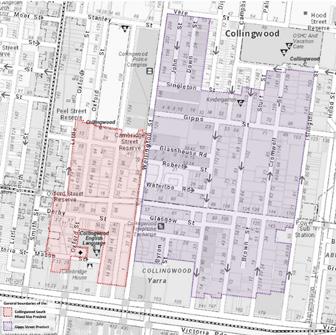
The Strategic Context
Michelle King, and Julian Larkins, Yarra City Council
The release of the Melbourne Industrial and Commercial Land Use Plan (MICLUP) last year provides further guidance on industrial and commercial land use planning across metropolitan Melbourne.
The document has re-established within State policy that the Gipps Street Precinct is significant not only locally, but on a regional scale. Yarra’s Spatial Economic and Employment Strategy (SEES) recognises the Gipps Street precinct as one of two large consolidated major employment precincts (Cremorne being the other). This is an area where a greater provision of floor area for an employment focus is encouraged.
Turning to the Collingwood Mixed Use Precinct, it is local policy that is driving the change in this area. The Yarra Housing Strategy (YHS) identifies that the precinct includes a variety of opportunities for incremental, moderate and high change and proposes to include the precinct within the Smith Street, Collingwood / Fitzroy Major Activity Centre.
This is viewed as a significant and important change in thinking away from linear activity centres concentrated on main roads to a precinct approach. With this outcome proposed within the local policy re-write the result will be important in shaping the future of activity centre planning for Collingwood.
The Challenges
A key challenge for the Gipps Street Precinct is the lack of clarity around expected built form outcomes. The existing Design and Development Overlay (DDO), over 10 years old, is not in tune with the recent built form approvals. This need for built form guidance is acknowledged within Council’s SEES, providing a basis for further strategic work to take place in the area.
…continues over page
29 / VPELA Revue October 2021
Places
Figure 1: Collingwood Mixed Use Precinct and the Gipps Street Major Employment Precinct.
For the Mixed Use Precinct, the key constraint is the intermix of development sites and existing single and double-storey residences side-by-side. Balancing reasonable expectations for both anticipated development and existing residential amenity will be the challenge. With an interim DDO in place, the proposed permanent DDO for the area has been referred to the Yarra Activity Centres Standing Advisory Committee and will be one to closely watch.

Great design is not only about providing aesthetically pleasing development, but about promoting and enhancing the pedestrian or human experience which in turn can have numerous benefits to communities and human wellbeing. The human experience must therefore always be central to our decision-making.
Michelle King is Principal Statutory Planner, and Julian Larkins is Coordinator Statutory Planning at Yarra City Council.
Membership Subscriptions Now Overdue
Our Role
Planners often downplay or underestimate just how important our work is in achieving high-quality outcomes that can enhance places and human wellbeing. But the way in which buildings, places and spaces are designed matters right down to the very minute detail. Striving for design excellence is at the heart of what we do.
If you have not received your 2021-2022 membership renewal by email, please contact the office on 9813 2801 to pay your subscription or obtain a copy of your invoice. Alternatively, you can email info@vpela.org.au
30 / VPELA Revue October 2021
Figure 2: Gerner projects, Wellington Street.
The Business Everything you wanted to know about adverse possession but
were too afraid to ask
Introduction
The following is an overview of the principles of adverse possession and concludes with some suggestions about how to manage disputes that can often take on a life of their own.
The opening words in Cervi v Letcher might fairly describe many adverse possession cases: “This proceeding concerns a neighbour’s dispute, of an extreme kind.”
The key to managing adverse possession disputes is to collect and circulate evidence early, and in an open and transparent way. A common mistake by litigants (and practitioners) is not gathering evidence early enough, or worse, wanting to hold evidence back for trial.
Basic principles
In the absence of evidence to the contrary, the owner of land with the paper title is deemed to be in possession of the land.
However, section 42(2)(b) of the Transfer of Land Act 1958 (Vic) provides an exception to the principle of indefeasibility, stating that title is subject to rights subsisting under adverse possession:
42 Estate of registered proprietor paramount
(2) Notwithstanding anything in the foregoing, the land which is included in any folio of the Register or registered instrument shall be subject to— …
(b) any rights subsisting under any adverse possession of the land; …
notwithstanding the same respectively are not specially recorded as encumbrances on the relevant folio of the Register.
Adverse possession may be described as a shield to fight an action to recover land. Section 8 of the Limitations of Actions Act 1958 provides:
8 Action to recover land
No action shall be brought by any person to recover any land after the expiration of fifteen years from the date on which the right of action accrued to him or, if it first accrued to some person through whom he claims, to that person…
Section 9(1) states that a right of action accrues upon the date at which the person whose title stands to be extinguished ‘has… been dispossessed.’
To establish adverse possession, a trespasser must show factual possession and an intention to possess the land in question.
Matthew Townsend, Victorian Bar
Factual possession must be single and exclusive, but this is dependent on the circumstances
The degree to which acts constitute a sufficient degree of exclusive physical control depends on the circumstances, in particular the nature of the land, and the manner in which the land has been commonly used or enjoyed.
What must be shown is that the alleged possessor has been dealing with the land in question as an occupying owner might have been expected to deal with it and that no-one else has done so.
A trespasser must make it clear to the world that the land has been possessed
The courts will require clear and affirmative evidence that the trespasser, claiming possession, not only had the requisite intention to possess, but made such intention clear to the world.
This does not mean that there must be a conscious intention to exclude the paper title holder. What is required is an intention to exercise exclusive control.
That the adverse possessor believes herself to be the true owner, might be quite sufficient to demonstrate an intention to possess.
Enclosure by itself, prima facie, indicates the requisite intention
If the disputed property becomes separated from the land belonging to the paper title holder by a fence, hedge or wall, so that the paper title holder can only gain access to the disputed property with the trespasser’s consent, and the trespasser makes more than minimal use of the disputed land, the courts will readily find that the trespasser has taken possession of the disputed property.
A person asserting title may do so in reliance on predecessors in title

Periods of adverse possession by successive occupiers can be aggregated if there was no gap in the period of adverse possession, even though there has been no express assignment of the possessory rights to land.
Possession over part of the land may be sufficient to establish possession over the whole of the land
Acts of possession with respect to only part of land claimed by way of adverse possession may in all the circumstances constitute acts of possession with respect to all the land claimed.
…continues over page
VPELA Revue October 2021 / 31
Once a limitation period has expired, the interest of the adverse possessor cannot be abandoned
At least probably, once the limitation period has expired the interest of the adverse possessor, or of a person claiming through him, cannot be abandoned.
Each case must be decided on its facts
While previous cases can provide guidance as to the relevant principles which are to be applied, each case must be decided on its own facts. Acts that evidence factual possession in one case may be wholly inadequate to prove it in another.
A court will decide what is the most probable inference to make on the evidence that is available.
Later conduct may throw light on earlier circumstances
In some case, the courts have been willing to look at acts by a trespasser after the commencement of the limitation period as shedding light on whether the trespasser was in possession throughout the whole period.
Adverse possession must be continuous and uninterrupted
Adverse possession must be continuous and uninterrupted. If the trespasser’s possession is interrupted by the paper title holder, or if the land ceases to be possessed by anyone, the ‘clock’ resets and the fifteen-year limitation period begins again.
Mere use of land may not be sufficient
In some circumstances, a person’s use of land may amount to enjoyment of a special benefit from the land but casual acts of trespass will neither constitute factual possession nor demonstrate the requisite intention to possess.
Evidence should be collected early and with care
Evidence in adverse possession cases is often called from landowners, neighbours and predecessors in title, whose recollection may be hazy, particularly in relation to times a decade or longer ago.
As the Court explained in Roy v Lagona there is, with the passage of time a natural dimming of recollection and memory:
45 In assessing the credit and reliability of the witnesses for the purpose of fact finding I have regard to the difficulty in accurately recollecting statements and events that occurred years ago. There is, with “the passage of time … a natural dimming of recollection and memory”. It is trite but true that human memory is fallible. It may fade with time, and may be affected by recollection partially true, or innocent but inaccurate reconstruction of what is thought to have been said or observed. Sometimes, also, understanding and recollection may be affected by the interest of the person giving evidence, even quite innocently. The judicial task in these circumstances is difficult, yet must be undertaken by the court in order to resolve the parties’ dispute. Steadily bearing in mind considerations of this nature, and having carefully read the transcript, and clearly recalling the witnesses, I have concluded as follows concerning the credit and reliability of the witnesses.
Aerial photography is therefore often useful, but the image quality at 15+ years for NearMap, MetroMap and Google Earth can be poor if images are available for the relevant period at all.
On the other hand, Photomapping has access to aerial photography and satellite imagery dating back as to the 1930s. Images are sourced from their own projects and the archives of State and Commonwealth Governments.
Adverse possession disputes are often fought over parcels of land of low value and as with some planning disputes, can be a proxy for other issues. In Kierford Ridge Pty Ltd v Ward [2005] VSC 215 the land was 2.4m by 1.1m and in Nicholas Olandezos v Bhatha & Ors [2017] VSC 234 the value of the land was ~$3,850.
To help ensure legal and other costs in proceedings are reasonable and proportionate to the amount in dispute, evidence in adverse possession cases should be collected early and made available to any party with an interest in the proceedings.
After all, a person whose name is on the title to land should not be expected to surrender those rights on anything other than the best of evidence.
Matthew Townsend is a member of the Victorian Bar and teaches Restrictive Covenants, Theory and Practice, as part of the University of Melbourne’s property law program. e: townsend@vicbar.com.au
32 / VPELA Revue October 2021
YPG Young Professional Group 2021 event wrap up

After another 12 months crossing paths with glimpses of freedom in various forms (constantly pivoting as we have learned to do), we reflect on how fortunate we were to gather together and share moments, which in retrospect, now seem so precious.
As always, the YPG would not be here without our wonderful hosts, panellists, participants and attendees of events/ webinars throughout the year, and we extend our thanks for their persistent positivity, adaptability and enthusiasm. We wish to extend our particular gratitude for the generosity of our sponsors Biosis, Traffix Group, Urbis and Taylors, and to VPELA for its steadfast belief in the value of the YPG. We acknowledge that while it has been another difficult year, the perseverance of our multidisciplinary community to continue to come together, learn and share, has shone through yet again.
And so now to cast our minds back to the start of 2021…
Speed networking – 17 March
In March we saw our first event of the year kick off with a ‘virtual’ take on our annual speed networking event. Forging ahead, although with some apprehension as to whether ‘Zoom fatigue’ had officially set in, we were overwhelmed at the turnout. Led by Lina Inglis, Charlie Wurm, and Jack Chiodo, professionals from across the spectrum of industry (and the state) joined together from the comfort of our homes to mingle, exchange ideas, and build connections. It was a great way to start the year, coming together to unite in our shared challenge of remote working, and the love of what we do that keeps us going!
Masterclass Series
1: “You’ve got a site, now what?” A guide to pre-lodgement –

17 June
While we were so close to hosting our first in-person event for the year, alas we determinedly adapted again to trusty Zoom. Chaired by Marji Kennedy (Melbourne City Council) with panellists Hugh Smyth (SJB Planning), Lina Inglis (Ratio Consultants) and Justin Galligan (Hampton), participants tuned in online to hear about the challenges, tips and pitfalls for putting together a viable proposal. Some key takeaways were the importance of understanding constraints and risk management (such as existing vegetation, access, and that all-important car parking…and bins) as well as logistics and engaging early with authorities. We followed along (reflecting on our own projects) taking notes as the panel deftly guided us through examples of deal-makers and deal-breakers.
The discussion was followed by Q and A, allowing the audience to delve deeper and gain insights to further their under-standing of this foundational part of the planning process.

2: “Running the planning application gauntlet” – 1 July
The first day of July turned out to be a magical date, when we were finally able to hold our first in person event for the year! Hosted by Urbis in the magnificent Olderfleet building on Collins Street, we gathered (at an appropriate safe distance) to hear from James Coutts (Department of Transport), Erin Baden-Smith (DELWP), and Zac Van Grondelle (City of Greater Geelong), ably chaired by Kim Piskuric (Harwood Andrews). The panel discussed key aspects of the application process, particularly when needing to involve authorities including DoT, DELWP, and Council. The key messages for prospective applicants were “engage early through the correct channels” and “provide all the information” to ensure a smooth process and identify key concerns at the start. Another theme raised was the importance of being open, and responding, to feedback to overcome challenges. Although planning can be an adversarial space, it needn’t always be, and by keeping the above in mind this can be avoided.
VPELA Revue October 2021 / 33
The year that was (different than we hoped for… again)
Emily Mignot, Monash City Council and YPG Committee
member
With great enthusiasm, after a thought provoking Q and A to wrap up the discussion, participants descended upon canapés, drinks and chatter just like the good ol’ days (but with masks, of course).
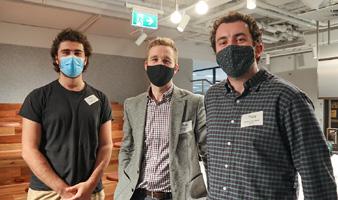

3: The final step in the planning process: “We can’t agree/the clock is ticking, off to VCAT we go” – 15 July
The third of the masterclass series explored the final step in the planning process… the Tribunal. Once again, changing circumstances demanded a return to the screens and with great aplomb the final session was held, chaired by Sean McArdle (Victorian Bar) and joined by panellists Ed Wilkinson (Stonnington City Council), Eliza Minney (Best Hooper Lawyers) and Michael Deidun (VCAT).
For those in the early stages of their interaction with the appeals process, and those to whom the Tribunal is still shrouded in mystery, the panel provided plenty of sound advice. Chief among the themes was the importance of submitting complete and accurate documentation, including the original application and Statement of Grounds, and accurate estimation of the time required for the submission, so as to prevent delays and secure your spot in the queue. A good rule of thumb to remember: half a day per expert witness. Similarly, they stressed the importance of completeness of the Statement of Changes in the event of an amendment. A particular example raised was including changes to setbacks, as this may precipitate a requirement to notify affected parties. Finally, with limited ability for Tribunal members to undertake site inspections due to restrictions, another key tip – providing photos (where possible) is paramount.
In trademark masterclass fashion the event was followed by questions from participants, enabling a further exploration of any of the topics raised, and an opportunity to answer any burning questions.

The wrap
All in all, despite a sparser social calendar than normal, the YPG were thrilled to have been able to offer a series of events to our community, bringing people together in pursuit of professional enrichment and connection. We hope to see a gradual return to the real-world in the months ahead and thank everyone for their ongoing support and enthusiasm. Stay safe and see you soon –the YPG committee.
Emily Mignot e: Emily.Mignot@monash.vic.gov.au
34 / VPELA Revue October 2021
Webinar
Net zero emissions: A grand vision for a sustainable future or a vacuous political position?
This is an edited version of Tony Wood’s VPELA zoom. Tony was due to address delegates at our conference in August but graciously agreed to speak to his presentation topic when the conference was cancelled due to Covid restrictions.

In a very short space of time, we have gone from the idea of wanting to reduce greenhouse emissions, to wanting to achieve this term “net zero”. My suspicion is that very few people who use this term think about what it actually means. What does it mean? Is it good or bad? What is the difference between zero and net zero? You can think about it this way. Before the industrial revolution the greenhouse gas emissions that were produced by humans and animals were basically offset by the absorption of those gases by plants and oceans, so the planet was in balance. As a consequence of human activity, over the last 300 or 400 years, this is no longer true. And what net zero means is getting back to that balance. That means that we not only have to reduce our emissions but also that anything that we are still emitting has to be offset by taking greenhouse gases out of the atmosphere and that is something that is hard to do.
Now, on the political side, things are also are changing. There is pressure around the world for governments across the globe to address climate change seriously. You only need to look at the wildfires that the northern hemisphere has had in the winter of 2021 to know what the impact will be from such partially climate change related events. The emissions produced by the wildfires was more than twice Australia’s annual total emissions. This is serious stuff!
4
Pressure to take action is mounting
Countries are making commitments. And you’ll see in Figure 2, the top left hand side is the number of countries that have made commitments to net zero. It’s true that many of them have not reflected those commitments in legislation. And that’s what that chart shows the dark red at the bottom of each of those bars is what’s actually been locked into law. So, we’re heading towards 80% of global emissions covered by net zero pledges, which says this is where the world is going.
So, let’s look at the numbers and some key metrics which will help us understand; the nature of the problem, where we are at the moment, and how we are tracking with regard to the future. If you look at Australia’s greenhouse gases in 2005 (which is the baseline we have chosen to use for evaluating our progress in emission reduction) see Figure 1, we were generating just over 600million tonnes, and we are now sitting just under 500 million tonnes per annum – (that might be a bit of a covid-related reduction). On average between 2005 and 2020, we have been reducing levels at approximately 7 million tonnes a year, but we need to get to an average of 24 million tonnes a year to reach our target of 26% reduction by 2050 and clearly that is a significant change.
Australia is not on track for zero
by 2050
by 2050
So, what are the Australians numbers? I’m not going to go through these in detail, but I want to give you a bit of a feel for what’s going on here. So, if you look at Figure 3 you can see what is predicted to happen between now and 2030 in each of the sectors.
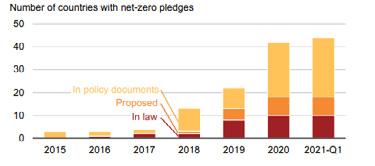
VPELA Revue October 2021 / 35
3
Tony Wood, Energy & Climate Change Director, Grattan Institute
emissions
0 100 200 300 400 500 600 700 2005 2006 2007 2008 2009 2010 2011 2012 2013 2014 2015 2016 2017 2018 2019 2020 2021 2022 2023 2024 2025 2026 2027 2028 2029 2030 2031 2032 2033 2034 2035 2036 2037 2038 2039 2040 2041 2042 2043 2044 2045 2046 2047 2048 2049 2050 Australia's emissions (mtpa) Historical plus current projections Trajectory for 26% target Trajectory for
6.8 mt per annum 3.5 mt per annum 23.9mt per annum
zero by 2050
3
emissions
0 100 200 300 400 500 600 700 2005 2006 2007 2008 2009 2010 2011 2012 2013 2014 2015 2016 2017 2018 2019 2020 2021 2022 2023 2024 2025 2026 2027 2028 2029 2030 2031 2032 2033 2034 2035 2036 2037 2038 2039 2040 2041 2042 2043 2044 2045 2046 2047 2048 2049 2050 Australia's emissions (mtpa) Historical plus current projections Trajectory for 26% target Trajectory for zero by 2050 6.8 mt per annum 3.5 mt per annum 23.9mt per annum
Australia is not on track for zero
Figure 2: Number of countries with net-zero pledges.
…continues over page
Figure 1: Australia is not on track for zero emissions by 2050.
Outside electricity, there’s very little emissions reduction expected in Australia over the next decade Emissions per year (millions of tonnes)
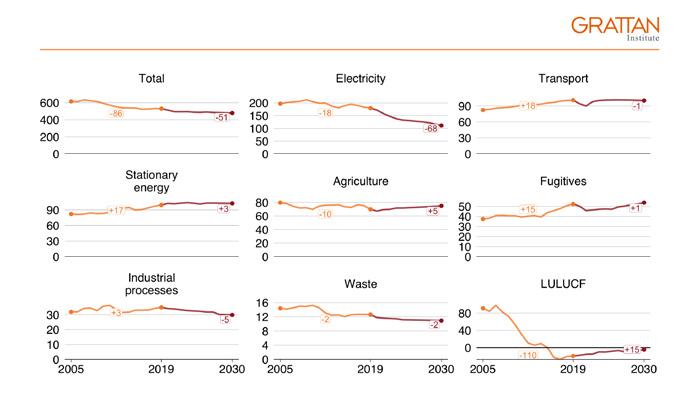
The circled number on the top left, total emissions, will reduce between now and 2030 on the government’s predictions by about 51 million tonnes per year. However, within this forecast, electricity generated emissions will reduce by 68 million tonnes. This means that significant sectors of the rest of the economy, transport, stationary energy, etc will all be going up. This is clearly not a trend that can be embraced if we are serious about getting to where we need to go.
If you look at the data in Figure 4, it is a quick snapshot of each sector and what’s going on in each sector. This allows us to understand what is physically causing emissions, what is projected to keep causing emissions, and what we should do about it.
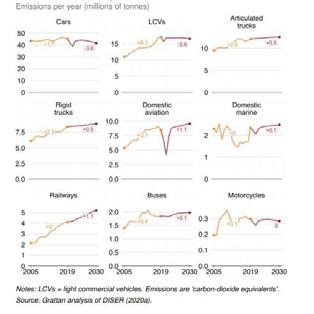
Looking at transport you can see by far, the biggest contributor to transport emissions is cars. With commercial vehicles, they are responsible for 60% of our emissions. So not surprisingly, that’s where we should start. That’s where things like battery electric vehicles are a known solution. In Australia we don’t actually have emission standards. We’ve not yet embraced even something as simple as imposing an emission standard. Trucks are a bit more challenging because of the way battery electric trucks are made, but the impact of the weight of the battery is quite a significant impediment. Even though you can see emissions in the other sectors are mostly predicted to go up they are from relatively small numbers. And again, with things like aviation and marine emissions. It’s really hard to see what the solutions might be.
The details matter: Transport and Industrial emissions
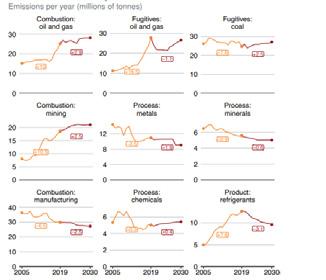
36 / VPELA Revue October 2021
6
Source: Grattan analysis of DISER (2020a).
Figure 3: Outside electricity, there’s very little emissions reduction expected in Australia over the next decade. (Grattan Institute)
Figure 4: The details matter: Transport and Industrial emissions. (Grattan Institute)
Agricultural emissions look even harder
Animal emissions dominate the agricultural sector
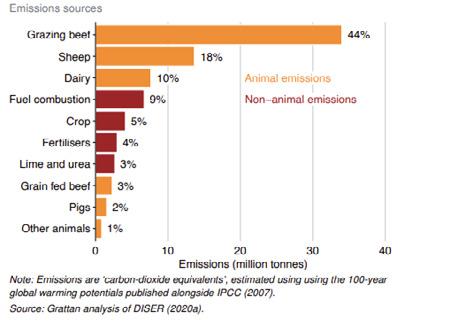
On the right hand side of Figure 4 are industrial emissions. After electricity generation these are the biggest source of emissions. This is basically the extraction of coal and oil and gas. And the thing that’s been driving emissions up quite dramatically, is the LNG process. This isn’t the emissions that are produced when we sell this gas overseas. This is the emissions that are produced in the extraction and liquefaction of that gas to export. It’s a big deal. And some of the big projects which have come online have contributed to very sharp increases and are projected to continue to do so.
Agriculture, this is one you don’t even want to look at, really. In many parts of the world, because it’s too bloody hard, Governments just exclude it. It is a bit like someone who’s wanting to lose weight who says “Well, of course, I’m going to stick to my diet, but I have to exclude the two McDonald’s burgers I have every day because I can’t stop eating them”. Good luck!
I’m not having a go at people who eat McDonald’s or people who eat beef, but the number is very, very sobering. Now 75% of our beef is exported, yet the emissions that are produced from producing that beef are here in Australia. By the time the beef gets into the supermarket or the butcher shop, it is no longer producing emissions. It’s the living cow that produces the emissions. Whereas with a coal mine it is the opposite, only a small amount of emissions (relatively) occur in Australia. Most of the emissions produced, are when that coal is burned in the country to which we sell that coal. However, what is common between beef grazing and coal mines extraction is that it is really hard to see how we’re going to reduce emissions from those two sectors. Almost certainly in the case of coal, we will have to stop coal mining. The fugitive emissions from open cut coal mines are the problem more so than anything else, because you can’t capture and store those emissions. Beef is the same. The sort of solutions people are thinking about are theoretical, questionable, and not very big. That is why these emissions are not predicted to come down and it is because in some cases, we don’t know what to do about them, literally.
Ultimately, the solution may very well be in removing emissions from the atmosphere. Removing things from the atmosphere or offsets is very different to avoiding emissions. You will hear many organisations talk about being ‘carbon neutral’, or they want to offset their emissions by putting a few more solar panels on the roof and selling that renewable electricity to the grid. That is not what I’m talking about here. By the time we get to net zero, reducing emissions won’t count. We have got to be taking emissions out of the atmosphere. There’s only a couple of ways that we really know how to do this. None of them are simple.
We can consider two methods. One is what’s called ‘direct air capture’. This is basically an industrial process where you pass air through large fans over a filter. A chemical process removes the CO2 from the air, and it does something with it. Mostly, the idea is to bury it deep underground. Problem is that it uses a huge amount of energy to do that. At the moment, the cost of emissions in Australia is about $20 a tonne of CO2 equivalent. In the European context it is about 50 to 60 euros a tonne. This method would cost more like $1,000 a tonne. But it’s important because it may be one of the few things we can do to solve our problem.
Another method is to take advantage of that process I mentioned at the very beginning where plants reduce or remove the CO2 from the atmosphere. The CO2 gets captured in the plant shoots and the plant roots and becomes caught up in the soil.
So, we can remove emissions from the greenhouse gases from the atmosphere by using these processes. The trick is, (and someone encapsulated this nicely for me not very long ago) when they said “Well, the problem with is, we really don’t know whether we’re putting the carbon into the tree, or into the ground. We don’t know if it’s still there. And we’re not too sure how to measure it. But, apart from that, it’s pretty straightforward. “
In addressing these challenges, most of the current activity in the technology community is trying to get a handle on these
VPELA Revue October 2021 / 37
7
Figure 5: Agricultural emissions look even harder. (Grattan Institute)
numbers. Is it physically possible? Does it have integrity in terms of reducing emissions? Can we measure it? And if you can create a credit, will someone pay for it?
So, what do we have to do? There are a couple of things. First, I don’t think community net zero is the answer. We must start at the place we want to finish. To expand, I am not fixated by ‘net zero by the 29th of December 2049’. It is what we do between now and then that counts. How much CO2 do we put into the atmosphere? If we put more emissions into the atmosphere in the meantime, those emissions are going to hang around for an awful long time. However, I think that being committed to net zero gives us an idea of the journey. It is a bit like saying that we’re going to travel to the United States, but we’re not quite sure when we’re going to get there. But we are going to start. And we’re not even sure when we’ll hit land. But we’re going to start, and we have to start now. Apart from electricity generation emissions, we haven’t started. We don’t have any constraints on emissions from those sectors outside electricity. We also need to recognize the role of technology. The government talks a lot about technology and not taxes. I agree that technology is absolutely critical to what has to be done to reduce emissions in most sectors, including electricity, but it won’t happen without policies, and it won’t happen without financial markets to deliver the investments necessary to deploy those technologies when we get the cost to the point where they’re affordable. So, we need all three.
I think we need a form of an economy-wide framework to do this. We could do this by a sector based approach, but the problem
is that, but they will almost certainly be more expensive. Also, they’ll be more inefficient.
In 2021, there are things we can do now, which would be cost effective actions. We need to support research and development to drive down the cost of the technologies we know about, but which are still very expensive. A lot of the things that are covered by the word ‘hydrogen’ come into that territory, and ‘carbon capture and storage’, comes into that territory.
And then there are things we really don’t know about. We don’t know how to get emissions out of the cement industry. We’ve got some ideas about how to get emissions out of the steel industry. We have got a very poor understanding of how we might get emissions out of the agricultural sector. We have only got some vague ideas about how we’re going to get emissions out of some parts of the transport sector.
These are the sectors that we should be concentrating on now. But some of the actions related to reducing emissions will only be possible within a few years and some of them won’t be possible for at least another decade or more. So that’s where we are.
We need to get moving across these sectors. The numbers show very clearly that we are not heading in a good direction. The government will claim that we have achieved their 2020 target and we are close enough to being on track to achieve our 2030 target and they are right. Unfortunately, the things that got us these reductions are not going to continue. And we need to change direction.
The Business Victorian Government School Site Selection Criteria Guidelines and Toolbox
Victorian school site selection criteria are now available on the Department of Education and Training’s (the Department) Policy and Advisory Library (PAL). It takes the form of Guidance and a Toolbox.
This outlines the key factors considered by the Department when assessing proposed Government school site options. It aims to provide school communities and broader communities with the reassurance that the selection of a proposed school site is based on a comprehensive assessment of the site’s suitability.
Victorian Government School Site Selection Criteria Guidance webpage
The Toolbox is a detailed resource on implementing and applying the general principles and requirements described in the Guidance at a greenfield, established or high density area level. The Toolbox is primarily intended for use by internal Departmental teams, but can also be used as a reference for urban planners
and designers, developers, other government agencies and Local Government. Schools may use it for understanding the Department’s site selection and school planning processes.
Victorian Government School Site Selection
Criteria Toolbox webpage
The Toolbox can be downloaded as a pdf document or an accessible Word document:
Victorian Government School Site Selection Criteria Toolbox - pdf document
Victorian Government School Site Selection Criteria Toolbox - accessible Word version
For further information, contact Department of Education and Training by email: provision.planning@education.vic.gov.au
38 / VPELA Revue October 2021
Webinar Electrify everything webinar
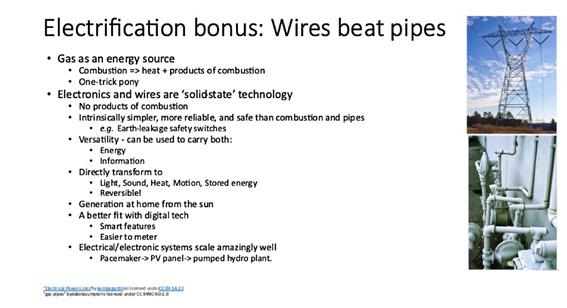
On Thursday 2 September, I had the pleasure of facilitating the Electrify Everything Webinar. With three diverse speakers and lots of information to share, the session generated lots of great questions from the audience and as one of the speakers, Euan said, this is a conversation that needs to continue.

The scene for the webinar had been set with an environment where there are calls for a gas lead recovery and fueled by increasingly urgent climate change forecasts. The session aimed to explore what is happening with Councils banning gas, architects exploring electric only buildings, traffic engineers pushing electric vehicles, and developers scrambling to innovate and get ahead of the pack.
The session commenced with Richard Keech, a Senior Consultant with Enhar, and author of ‘The Energy Freedom Home’ (Scribe, 2015) and co lead author of ‘Zero Carbon Australia Buildings Plan’ (BZE, 2013) setting the scene on trends, challenges and opportunities and his own experience in retro fitting verses undertaking a new build (at The Cape development in Cape Paterson).
Once the scene was set, we then heard from Ben Callery, a Melbourne-based architect who has designed and built many environmentally friendly houses over the past 18 years. Ben discussed the opportunities and challenges of working with clients to understand their options for the key areas in a home that can be electrified including, space heating, domestic hot water, cooking and pools. Ben provided great visual examples and also explored the challenges especially in retro-fitting homes on small allotments where electric
utilities often require greater space (down sideways of dwellings etc) and could create noise issues for neighbours.
Finally, the session was rounded out by Euan Williamson, Environmentally Sustainable Development (ESD) Advisor for the City of Yarra who shared his experience in ESD and sustainable energy and how he is exploring how best to use the planning scheme to deliver zero carbon developments and how the City of Yarra demonstrated leadership by removing gas from their own buildings (not without its challenges).
The highlight however was the questions that were raised during and explored at the end of the session. For me it demonstrated that there is an eagerness to continue to explore this issue/opportunity and importantly that the time to act and implement is now.
Listening to the speakers and the questions being raised – it was not so much about why we should be electrifying, but more about the how and how to do it now. The challenge is how do we provide a regulatory framework that encourages innovation, facilitates new ideas to be delivered on the ground in a timely manner, and importantly brings the rest of the sector along.
I know Richard, Ben, Euan and myself look forward to continuing the conversation, to ensure we all achieve an environment where we have electrified everything.
VPELA Revue October 2021 / 39
Jodi Kennedy has extensive local government experience and is a VPELA Board Member.
Jodi Kennedy, General Manager Resilient Communities, Bass Coast Shire.
YPG Masterclass…
Running the planning application gauntlet
VPELA
– A MULTI-DISCIPLINARY PROFESSIONAL ASSOCIATION





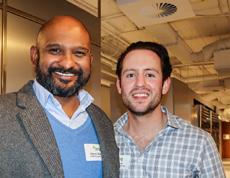
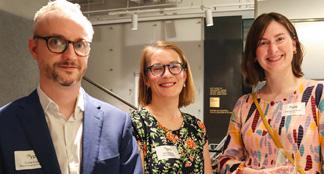
Established in 1989, the Association holds regular seminars, social events and a conference annually. It also reviews legislation, provides high level advice to Government and makes submissions to all aspects of land use planning. If you have any questions or are interested in joining the Association, contact Jane Power, Executive Officer.
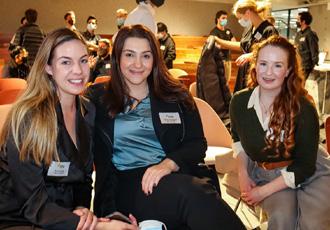





































 (2001-2003)
(2001-2003)





























